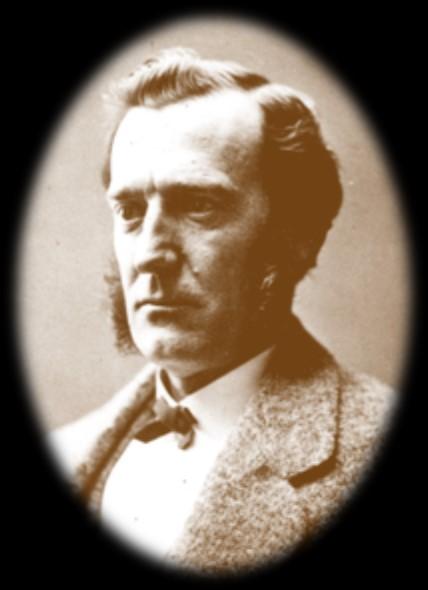Number 14
April 2021


Heroes Among Us
Mystery Photos
Luther J. Wyckoff: Growing Lavender on Chambers Prairie Artist Edward Lange and Tumwater, Washington
Number 14
April 2021


Heroes Among Us
Mystery Photos
Luther J. Wyckoff: Growing Lavender on Chambers Prairie Artist Edward Lange and Tumwater, WashingtonThe Thurston County Historical Journal is dedicated to recording and celebrating the history of Thurston County.
The Journal is published by the Olympia Tumwater Foundation as a joint enterprise with the following entities: City of Lacey, City of Olympia, Confederated Tribes of the Chehalis Reservation, Daughters of the American Revolution, Daughters of the Pioneers of Washington/Olympia Chapter, Lacey Historical Society, Old Brewhouse Foundation, Olympia Historical Society and Bigelow House Museum, South Sound Maritime Heritage Association, South Thurston County Historical Society, Thurston County, Tumwater Historical Association, Yelm Prairie Historical Society, and individual donors.
Publisher
Olympia Tumwater Foundation
John Freedman, Executive Director
Lee Wojnar, President, Board of Trustees
110 Deschutes Parkway SW P.O. Box 4098 Tumwater, Washington 98501
360-943-2550
www.olytumfoundation.org
Editor
Karen L. Johnson 360-890-2299
karen@olytumfoundation.org
Editorial Committee
Drew W. Crooks Jennifer Crooks
James S. Hannum Erin Quinn Valcho
The Journal does not offer a subscription service. To get your own copy, join one of the heritage groups listed at the top of this page. These groups donate to the publication of the Journal, and thus receive copies to pass on to their members. Issues are also available for purchase at the Bigelow House Museum, Crosby House Museum, and Lacey Museum, and occasionally at Orca Books in downtown Olympia and Hedden’s Pharmacy in Tenino.
One year after print publication, digital copies are available at www.ci.lacey.wa.us/TCHJ.
The Journal welcomes factual articles dealing with any aspect of Thurston County history. Please contact the editor before submitting an article to determine its suitability for publication. Articles on previously unexplored topics, new interpretations of well-known topics, and personal recollections are preferred. Articles may range in length from 100 words to 10,000 words, and should include source notes and suggested illustrations.
Submitted articles will be reviewed by the editorial committee and, if chosen for publication, will be fact-checked and may be edited for length and content. The Journal regrets that authors cannot be monetarily compensated, but they will gain the gratitude of readers and the historical community for their contributions to and appreciation of local history.
Opinions expressed by contributors are not necessarily those of the Olympia Tumwater Foundation.
Written permission is required to reproduce any part of this publication.
Copyright © 2021 by the Olympia Tumwater Foundation. All rights reserved.
ISSN 2474-8048
Number 14
April 2021
2 Luther J. Wyckoff: Growing Lavender on Chambers Prairie Mary Paynton Schaff

21 Artist Edward Lange and Tumwater, Washington Drew W. Crooks
37 Heroes Among Us
Karen L. Johnson
46 Mystery Photos Back Cover
Who/What/Where Is It?
On
It is perhaps a little-known occupational hazard that librarians are often drawn into the questions they field to an alarming degree. Provide any of us with an intriguing historical fact or personage, and we are quickly down the research rabbit hole trying to find out what else may be discovered. After fifteen years at the Washington State Library, this has been my experience too many times to count but perhaps there is no better example than the search set off by Erin Quinn Valcho of the Lacey Museum in April 2015.
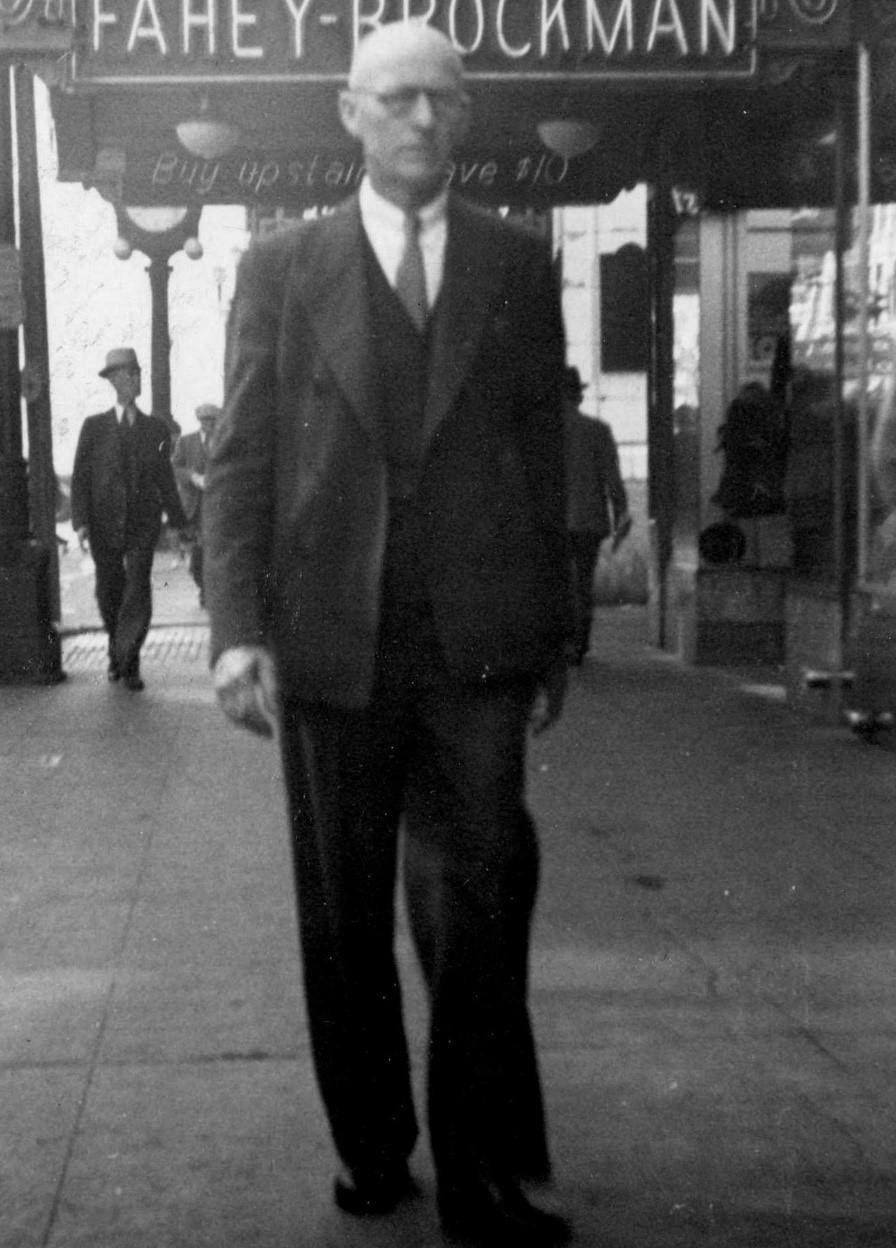
Erin wondered what the State Library had on the lavender farm that used to exist near the Horizon Pointe development in Lacey. She didn’t have exact dates at the time, but it was clear this was a very early example of commercial lavender growing in our state. I sent Erin the materials I was able to locate in our collections at that time, and she wrote an article that appeared in the Spring 2015 issue of Museum Musings.1
And yet even after Erin’s initial question was answered and her article written, the topic stuck with me. Who was L. J. Wyckoff? How did he get involved in lavender growing, and how
did his farm come to be forgotten? Nearly six years after Erin’s inquiry, it was clear that only a more in-depth examination of the Chambers Prairie lavender farm, and the intriguing man
behind it, would exorcise “the lavender farm question” from this reference librarian’s obsessive need to research it further.
L. J. WYCKOFF—EDUCATION AND WORKLuther James Wyckoff, identified as L. J. Wyckoff in all his professional writing, was born December 8, 1881 in Galesburg, Illinois,2 the eighth and last child born to James D. and Mary Wyckoff.3 Luther’s father was a Congregational minister who received his seminary training at Union Seminary in New York, and was awarded a Doctor of Divinity from Knox College in Galesburg. James spent much of his ministry in Stark County, Illinois, and at the time of his death in 1909 had one son serving as an Episcopal rector4 and another, Charles Truman Wyckoff, with a Ph.D. in History, serving as Dean of the Lower Academy at Bradley Polytechnic (now Bradley University) in Peoria, Illinois5 as well as two daughters working as missionaries in China.
It is unclear whether Luther Wyckoff pursued or obtained a secondary education like his brothers. The Wheaton College Register for both 1897-1898 and 1898-1899 shows him enrolled in the science department at Wheaton College preparatory school,6 but unfortunately no subsequent enrollment information could be verified. His professional writing shows he possessed a curious and inventive mind, but academic credentials were never cited. Wyckoff’s neighbor, Shirley Englehart Cronk, remembers him as “wonder-
fully intelligent” and “a well-educated agronomist.”7
A letter to the editor Wyckoff wrote to The Seattle Times in March 1932 indicates there may be reason to doubt he had a formal education after high school. In it, Wyckoff decried excessive spending on public schooling, urging cuts to both elementary and higher education:
“While I doubt if many would be willing to go as far as I would in reducing our elementary schools to their skeleton of the three ‘R’s,’ I believe every thinking person will agree that a great deal of adipose [fatty] tissue has appeared of recent years that could well be done away with . . . If we could close a majority of these institutions of higher learning . . . and restrict such education to those whose mental qualifications would indicate that such education would be of benefit and stop stuffing a lot of useless information into heads that have not the capacity to retain even a small fraction of it, we should be able to effect very considerable savings along this line, without loss to the nation as a whole.”8
Wyckoff appears in Seattle in 1906, boarding with his sister Susan and her husband Charles Congleton, an attorney.9 It seems likely his brotherin-law used his connections to assist Wyckoff in finding a job in real estate, as both are listed as working at the same address in the New York Building in downtown Seattle. However, it does not seem Wyckoff remained indebted to his brother-in-law for very
long. Subsequent censuses show Wyckoff spent the majority of his professional career in Seattle as a salesman, selling everything from leather belts to oysters to insurance.10 Wyckoff moved quickly on the family front as well: by January 1907, Wyckoff had married June Lee McKay,11 called Dearie by everyone in the family.12 Their sons Luther James Wyckoff, Jr. and John McKay Wyckoff were both born in Seattle by 1909.

Writing years later about his interest in growing lavender, Wyckoff attribut-
ed the start of his experiments with the plant to a dinner table discussion in the summer of 1926.
“Talking of the possibilities of small scale commercial flower growing, brought to mind the Lavender plants which grew so well in our gardens and the use of dried blossoms, long a standard practice. In suggesting this feature as an interesting side-line, I made a casual remark as to thinking that there was an oil produced from this flower as well.
“Having aroused my own curiosity and a subconscious pioneering instinct by
this remark, a visit to the library soon opened my eyes to the wide range of essential oils and gave me a mass of information as to the Lavender plant and its uses.”13
Wyckoff’s backyard lavender on Queen Anne Hill thrived in the Puget Sound region’s rocky and well-drained soil, and he observed that “the luxuriant growth and abundant blooms made by this plant in the Seattle region suggested the probability that it would produce considerable oil per acre . . .”14 Spurred by his experience, library research, and natural curiosity, Wyckoff began by attempting to find planting stock with which to test his ideas.
Wyckoff’s research indicated that “true lavender,” or Lavandula angustifolia (English lavender), would produce the highest quality lavender oil. He therefore set about gathering samples of English lavender from the large ornamental lavenders growing around the Seattle area, as well as from local nurseries.15
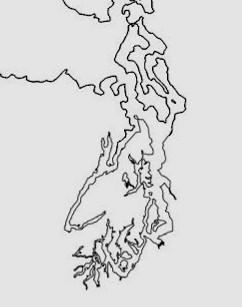
It was about this time Wyckoff’s partnership with the United States Department of Agriculture (USDA) officially began. The USDA had signed an agreement with the Associated Manufacturers of Toilet Articles in January 1924 which funded the investigation and development of raw perfume products.16 Investigation into lavender oil
production seems to have begun in the fall of 1927 with Wyckoff, when he recalled:
“One of their representatives called while in this district on other matters. After noting the seemingly favorable conditions, he made a proposition that I should act as collaborator with them under a project financed by a manufacturer’s association for the development of possible domestic sources of supply of this and other similar oils.”17
According to Rod Cook of Olympia, President of Ag-View Consulting, “collaborators” with the USDA were private citizen farmers who provided the driving interest in new types of agricultural crop opportunities, and who could be relied upon by USDA scientists to provide the field work, documentation, and experimentation with those new agricultural products for eventual scientific interpretation and commercial development.18 In the article he co-authored with USDA scientist A.F. Sievers, Wyckoff made it clear he counted on money from the USDA to provide “seed, planting stock, and distilling equipment.”19
The first major planting of young lavender cuttings, or slips, propagated from Wyckoff’s samples began in the spring of 1928 on two acres of cleared ground in Bothell. The first efforts to distill the plants into oil took place in 1928 and 1929 but were largely unsuccessful, according to Wyckoff’s reports. In 1930, the USDA provided the funding to set up a still at Bryant Mill and Lumber Company in Seattle20 where, finally, a substantial crop of oil was produced. Unfortunately, after scientific analysis, it was determined that the oil was of a poorer quality due to the fact that the plants processed were not true lavender after all, but varieties of hybrids (Lavandula x intermedia).21 Wyckoff and Sievers acknowledged that, “the botanical differences are so slight and the variations in type of the true lavender so considerable that it is almost impossible to definitively classify a plant as true lavender by inspection.” But the
apparent failure of the distillation effort was a blow, and seems to have been the primary cause for abandoning the Bothell location the following year.22
By March 1932, Wyckoff was back, moving his plants to an enormous 160-acre site at Oak Bay, one mile east of Chimacum in Jefferson County, in the hopes of generating more commercial interest in his project.23 During the intervening time, Wyckoff had sought to procure as many samples of true lavender as possible, even going so far as to purchase seeds and slips from France (all but about a dozen of the several hundred slips died en route).24 Wyckoff determined that the location on the Olympic Peninsula would have favorable climate and soils conducive to the growth of his plants. However, the hoped-for commercial interest did not arise and Wyckoff found himself in dire financial straits almost immediately:
“Just when it seemed everything was going smoothly, the proposed financing blew up, partly because of the Roosevelt depression and even more because of the peculiar methods of the government about that time. This left the operator way out on a weak limb, badly over-extended in the property tied up and like the Irishman and the wildcat, neither able to hang on or let go. Unable to clear more ground or care for the obligations assumed, the planting was moved to a secondchoice location on some prairie ground where a small tract was rented and arrangements made for a room with
The boundaries of the Plant Research Foundation’s property at one time spanned the entire triangle between Yelm Highway, Ruddell Road, and the Burlington Northern railroad tracks, as depicted on this 1968 USGS Topographic Map. Due to financial hardships, this expansion was fairly short-lived. The striped rectangle approximates the sixteen acres described by the Seattle Times in 1947 which made up the core of the lavender farm. The circled three small squares, on the east side of the current intersection of Ruddell Road and 66th Ave SE. mark the location of Wyckoff’s home and outbuildings, as Shirley Cronk remembers them “at the end of the lane.” U.S. Geological Survey, “East Olympia quadrangle, Washington –Thurston Co: 7.5 minute series (topographic),” 1969. Field checked 1959; photorevised 1968. Courtesy of the Washington State Library, FED MAP-7 EAST OLYMPIA 1969.

the owner of the farm. This ground had been farmed in grain for years and was badly worn out but as Lavender seems to prefer a rather poor soil,
it seemed to be fairly satisfactory and had to serve as the only thing available.”25
The Plant Research Foundation’s triangle of former property as shown by Google Earth in 2005, prior to the building of the Horizon Pointe neighborhood and Chambers Prairie Elementary School. Traces of old farm roads can be seen extending from the former location of the homestead at the intersection of Ruddell and 66th Ave. Image courtesy of Google Earth (accessed March 5, 2021).

DURING THE DEPRESSION
The rented “second-choice location” was a ten-acre plot on Chambers Prairie, located just south of the intersection of Ruddell Road and Yelm Highway, now the site of Chambers Prairie Elementary School. Wyckoff moved half of his Chimacum plants there in December 1932, and the rest in November 1933.26 While the set-up clearly was not ideal (he observed that if they had been able to retain the Oak Bay site it would have seen the largest
gross returns from any of his sites), he seemed determined to make his passion project work. For the next nine years, Wyckoff commuted to his lavender farm from Seattle, “with the operator driving down from Seattle Monday morning and trying to get a week’s work done by Thursday noon before returning to attempt a gainful occupation the rest of the week.”27
There was much to be done. Wyckoff busied himself propagating his plants, determining the best spacing and growing conditions on his acreage,
and experimenting with varieties of plantings and fertilizers. Some specimens of lavender germinated or grew better in certain types of soil drainage. Slight differences in cuttings or planting methods meant that some transplanted without difficulty, while others grew sluggishly after being moved. Lavender plants required weeding and harvesting in order to collect the oil. To those ends, Archie Englehart, Shirley Englehart Cronk’s father, was employed during the Depression to pull weeds at the lavender farm for 50 cents a day.28 And due to the unique nature of the harvesting of lavender, Wyckoff built custom lavender harvesting implements by hand out of old automobile and farm machine parts.29
The distillation of lavender oil must take place fairly quickly after harvesting. In 1933, facilities for distillation were secured at the property of F. L. Baker at Hewitt Lake, just three miles from the farm.30 A thousand pounds of lavender blossoms produced at the lavender farm were distilled into 6.4 pounds of oil in 1934. Perhaps hoping to get even more of the process under his direct control, Wyckoff purchased a confiscated moonshiner’s still from a United States Marshals Service auction on July 17, 1934. Unfortunately, the still was missing the condenser, a critical component. Wyckoff sued U. S. Marshal A. J. Chitty and was awarded $250 on September 19, 1935 for the faulty equipment.31
December 1934 also saw the termination of the agreement between the USDA and the Associated Manufactur-
ers of Toilet Articles.32 Wyckoff reported that the funding from the USDA was completely depleted in 1936, thus beginning a long struggle to keep the lavender farm afloat financially.33 Writing about his experimentation in lavender farming for The American Perfumer and Essential Oil Review in October 1935, he observed that commercial success in the production of lavender oil would require both many acres dedicated to planting and sufficient funding in order to allow the farmer to work full-time at the endeavor, rather than treat it as a hobby or sideline.34
L. J. Wyckoff finally obtained some stability for his lavender farm with the close of the Depression, financial hardships notwithstanding. Lavender grew well on Chambers Prairie and continued investments in upgrades at the farm made gradual improvements in the production of high quality lavender oil.
In December 1935, Wyckoff, his wife June, and their son Luther J. “Jim” Wyckoff, Jr., incorporated the nonprofit Plant Research Foundation “for the purposes of continued scientific research.”35 Relying on the skills he developed during his years in sales, Wyckoff Senior managed to solicit a $250 donation for the foundation from “a principal executive of a large perfume concern,” (the equivalent of $4,621 in today’s money) as well as a $3,000 investment (today’s dollars:
In 1935, Wyckoff, his wife June, and son Jim incorporated the non-profit Plant Research Foundation which purchased the property on Chambers Prairie. Secretary of State and Territory, Corporations and Trademarks, NonProfit Corporations, 1885-1983, Washington State Archives, Olympia, Washington.
$55,460) from another firm that expected “no return other than receipt of the small amounts of oil produced, which they used for testing and sampling the trade.”36
These donations to the foundation, as well as Wyckoff’s cashing in of personal assets, permitted the foundation to purchase the Chambers Prairie property and erect “a house of sorts,” as well as distilling facilities.37 Wyckoff listed himself as a farmer in the 1940 census;38 his part-time hobby farm was finally his full-time occupation. Luther and June moved to Chambers Prairie in 1941 and took up full-time residence in their home on what is now Ruddell Road.39
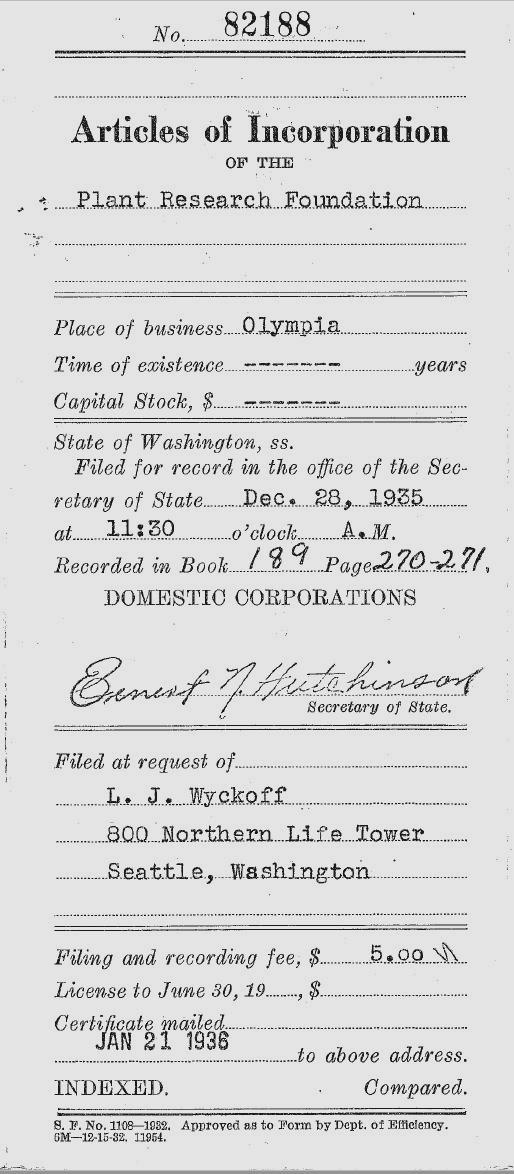
With Wyckoff stripped of a weekly commute from Seattle, he was now able to devote all his energies to the farm. The period from the 1940s through the early 1950s represented the pinnacle of the farm’s lavender oil production, and the entire family seems to have pitched in. Wyckoff’s granddaughter Emmy Fairfield recalls weeding the lavender plants with a hoe as troop trains full of waving soldiers passed the farm.40
The hard work paid dividends, including some much needed publicity for Wyckoff’s project. In 1947, the farm was featured in the Seattle Times Sunday Pacific Parade Magazine. It described Wyckoff as “the only known commercial producer in the United States of a crop called lavender” and waxed poetic about the place:
“From early July through mid-August, L. J. Wyckoff’s farm a few miles southeast of Olympia is the sweetestsmelling and most beautiful place in the country. Motorists going by sniff and sniff. Then they look out over waving acres of a lake-like field of varying shades of gorgeous color ranging from almost white to dark blue and all shades of lavender. Finally, they wonder what it’s all about. And railroad passengers who see this amazing spectacle certainly must conclude they’ve seen a mirage there is no lake with so many shades of color.”41
The Wyckoffs’ “house of sorts” (at least compared to the other houses where they lived on Queen Anne Hill in Seattle) on Chambers Prairie, circa 1940. The Wyckoffs’ granddaughter Emmy remembers the large window on the main floor looked out across the prairie to Mt. Rainier. Thurston County Government, Assessor, Real Property Assessment Photographs, 19361971, Washington State Archives, Olympia, Washington.

The profile described the farm as having twelve acres dedicated to commercial planting and four acres reserved for cultivation and experimentation, and featured a photo of Wyckoff working with his plants alongside John H. Seager, chief chemist at the prestigious beauty products company Yardley and Co. of London, England. Seager was quoted as saying that Wyckoff’s plants were “better than average” and that he intended to take several samples back to England with him to study and develop.
The relationship with Seager continued, according to an undated article printed in The Daily Olympian. On
page 1, the paper reported that Seager had not only returned the previous summer to assist “in test runs of the lavender oil and generally checking the operations,” he had arranged for 5,000 of Wyckoff’s lavender cuttings to be shipped from the Olympia Airport to London for planting “in English soil” by Yardley and Co.42
Another front-page article written in 1951 called Wyckoff’s operation “the only lavender farm in the United States,” and went into detail on his distilling process. A photo showed farm workers C. E. Curtis and Wallace A. Black putting 400 pounds of harvested lavender into a large steaming vat. At the conclusion of distillation,
Wyckoff stated he could produce 2½ pounds of lavender oil from the 400 pounds of lavender cuttings.43
Wyckoff’s accomplishments also appeared in various agricultural publications throughout the 1950s, including the Thurston County Soil Survey issued in 1958, in which it seems clear his observations about soil conditions conducive to the growing of lavender were cited without credit.44 The authors of the authoritative book on lavender, The Genus Lavandula, observed, “By 1950 Wyckoff had been producing lavender oil for nearly 25
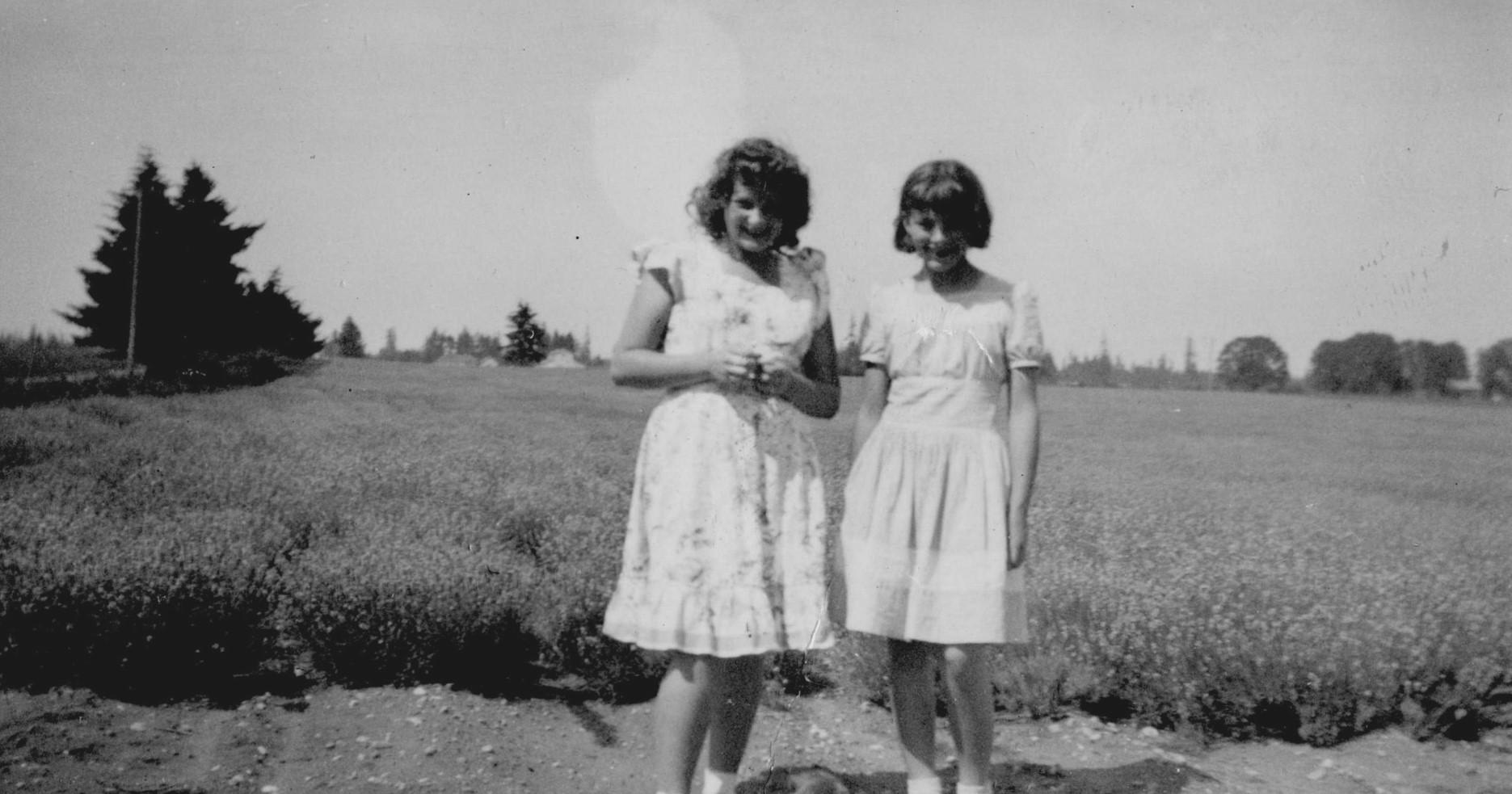
years and was regarded as the foremost authority on the commercial cultivation of L. angustifolia in North America.”45
Even as Luther Wyckoff received publicity for his unique farm, he already appeared to be predicting an end to his lavender-growing career. Wyckoff was 69 years old in 1951 when he wrote an article for Herb Grower Magazine about his experience growing lavender:
“The limitations of advancing years has deterred the operator from fanning what seemed to be a glowing promise into a successful flame but instead has had to be content to watch the dying embers turn to ashes. For all that, it has been fun in many ways, doing something different, learning things no one could tell you, making contacts with lots of interesting fine people and with the always supporting hope that the work done might result some day in real practical benefit . . . While this has been far from a success story, there is the hope that the experience gained might be of value to some other forward-looking individual who could go ahead with a real Lavender development.”46
From the beginning, Wyckoff had pursued the idea that commercial lavender growing could be profitable. Due to the Depression and other financial setbacks, Wyckoff was never able to retain the large amount of property he believed necessary to create a profitable commercial enterprise. Lavender growing was time intensive and expensive, especially during the early years of plant establishment, and in his writings, Wyckoff issued warnings that it was not expected to be profitable for the small farmer. Rather than conclusively proving that lavender farming could be profitable, Luther Wyckoff instead settled for the establishment of his nonprofit Plant Research Foundation and depended on donations given by likeminded individuals and more profitable corporations.
attle Times in 1950 indicates that Wyckoff might have resented this reliance. After condemning agricultural price supports that only benefited “factory-type farmers who least need them,” as well as the efforts of labor unions in general, Wyckoff decried government assistance programs:
“We have gone a long way on the road to socialism already. No better example is needed than the social security idea, spawned in Europe and grafted on to our economy by the vote-getters, despite it being so contrary to our older ideals of self-sufficiency, thrift and individual pride. It has already proved how sadly it has reduced the morale of the people as a whole and weakened the fibre of most people. . . . It does not make for a contented citizenry with one group of hard-working families existing on very small incomes and others doing nothing and receiving more.”47
A 1958 agriculture report indicated that Wyckoff’s lavender farm was still “reported to be the nation’s largest lavender farm,”48 but the writing was on the wall. In September 1960, Plant Research Foundation officers Luther and June Wyckoff deeded the farm property to the Northern Pacific Railroad in exchange for $10 and Luther being able to reside on the property for the remainder of his life.49 The foundation itself was officially dissolved June 26, 1962 by its officers L. J. Wyckoff, June Wyckoff, C. E. Curtis, and John M. Wyckoff.50
Another letter to the editor of The Se-
Luther J. Wyckoff died in Olympia on January 1, 1969 at age 87.51

The Wyckoff “house of sorts” was appraised in April 1968, according to the property records held at the Washington State Archives.52 However, after Luther’s death in 1969 it quickly became clear the railroad had changes in mind. Thurston County Fire District #3 purchased a portion of the old lavender farm north of the homestead on Ruddell Road from Burlington Northern Railroad in 1971,53 and built a fire
station on the site. The building still stands today but is now the Lacey South Precinct Police Station. Curiously, a short note at the bottom of the property records indicates that Fire District #3 burned the Wyckoff home at the request of the railroad sometime that same year.54 This story was also confirmed by Luther and June’s granddaughter Emmy Fairfield, who was told the home was burned as part of a training exercise55 the only portion of Wyckoff’s legacy literally “turned to ashes.”
Why did the railroad feel it necessary
to destroy the home? It seems a rather drastic step for a building that was only 30 years old at the time. The property records show a somewhat surprising 40% depreciation of the property in 1968.56 It is possible that the condition of the property alone merited its disposal. It is also possible that the home’s proximity to the railroad tracks had made it something of a nuisance. Emmy Fairfield recalls that when freight trains would pass the home, train-hopping migrant workers, possibly alerted by hobo signs or graffiti, would often knock on the door looking for a meal. Dearie would always oblige them, often with a sandwich and a piece of homemade pie made from the berries grown there at the farm.57 It is conceivable that train hoppers attempted to squat in the home or outbuildings after the Wyckoffs’ departure, thus warranting the destruction of all the buildings on the site.
Aside from the fire station property, Burlington Northern retained the lavender farm acreage, holding on to the land until the decision was made to build Centennial Station across Yelm Highway in the late 1980s. The former site of the Plant Research Foundation remained undeveloped until the Horizon Pointe neighborhood was built beginning in 2005. When land was cleared for the Chambers Prairie Elementary School in 2008, neighbors lamented the loss of the property’s trees and dirt bike tracks. No mention was made of the lavender that once grew there.58
One might wonder how things may have been different if Wyckoff had been able to develop his ideas at an earlier age. The discovery that he was working with the wrong type of lavender in Bothell delayed his seeing the true potential of his product by several years. The expiration of USDA funding limited his scope, as did the hardships of the “Roosevelt Depression.” Wyckoff even made attempts in the later 1940s to expand his Chambers Prairie property but was thwarted by his inability to obtain a loan for the new farmland due to the wholly unique (at that time) nature of his work.59
But Luther Wyckoff’s legacy is far from one vaguely remembered farm. It is all but confirmed that the L. angustifolia field varieties “Wyckoff Blue” and “Wyckoff White” were developed by him, and those varieties live on in nurseries and gardens across the country.60 The Yardley of London website states that true lavender cultivars sought out and developed by John H. Seager are still in use by Yardley in their lavender fragrances today.61
In addition, Wyckoff’s prescience about the suitability of climate of the Pacific Northwest, the Olympic Peninsula in particular, for growing lavender has stood the test of time. Sequim hosts an annual lavender festival every summer celebrating the success of the lavender industry in the northern Olympic Peninsula. Sixteen different lavender farms display on the Google map in the area just west of Wyckoff’s second location in Chimacum.62 Now far from being home to “the only
known grower of lavender,” Washington State hosts at least 85 lavenderrelated businesses according to the Secretary of State’s Corporations database.63
The author wishes to thank: Erin Quinn Valcho, Curator of the Lacey Museum; Karen Johnson, Curator at the Schmidt House; Lanny Weaver, President of the Lacey Historical Society; Jewell Dunn and Tracy Rebstock at the Washington State Archives; Rod Cook of Ag-View Consulting; David Luftig and Mark O’English at Washington State University Libraries; Eileen Price at the Washington State Historical Society; Wyckoff neighbor Shirley Englehart Cronk; and Cathy Banta, Interlibrary Loan specialist extraordinaire, at the Washington State Library for their encouragement, assistance, and patience in helping me tell this story. I would also like to say a special thanks to Emmy Fairfield, granddaughter of Luther and June Wyckoff, who generously shared her family’s stories and photos with me. I hope this story of your grandfather’s lavender farm will be one that can be shared in your family for many years to come.
2 “Luther J. Wyckoff,” obituary, Daily Olympian, January 2, 1969, page 7.
3 1900 United States Census, Milton, DuPage, Illinois, population schedule, page 3, dwelling 65, family 69, Luther J. Wyckoff; digital image, Ancestry.com, http://www.ancestry.com (accessed March 23, 2021).
4 Find a Grave, database with images, http://www.findagrave.com, memorial 107564253, James D. Wyckoff (18321909) (accessed January 19, 2021).
5 Bradley University, Bradley Polytechnic Institute: The First Decade, 18971907 (Boston: Harvard University, 1908), Google Books, http://books. google.com/books?id=A5oaAAAA YAAJ (accessed January 12, 2021).
6 Annual Register of Wheaton College, 1897-98 (Wheaton, Illinois: Wheaton College Press, 1898), page 71; Buswell Library, https://files.library. wheaton.edu/sc/lr/a-sc/archivespub lications/catalogs/1897-1898 catalog.pdf (accessed February 2, 2021). Thirty-Ninth Annual Register of Wheaton College, 1898-99 (Wheaton, Illinois: Wheaton College Press, 1898), page 71; Archives of Wheaton College, https://files.library.wheaton.edu/sc/ lr/a-sc/archives/publications/cata logs/1898-1899catalog.pdf (accessed March 24, 2021).
1 Erin Quinn Valcho, “Lacey’s Own Lavender, the Wyckoff,” Museum Musings, Spring 2015, page 1.
Luther and June Wyckoff in their later years, with their dog Roddy. Their granddaughter Emmy recalls her grandparents owning a string of collies, all named Roddy. Photograph courtesy of Emmy Fairfield.
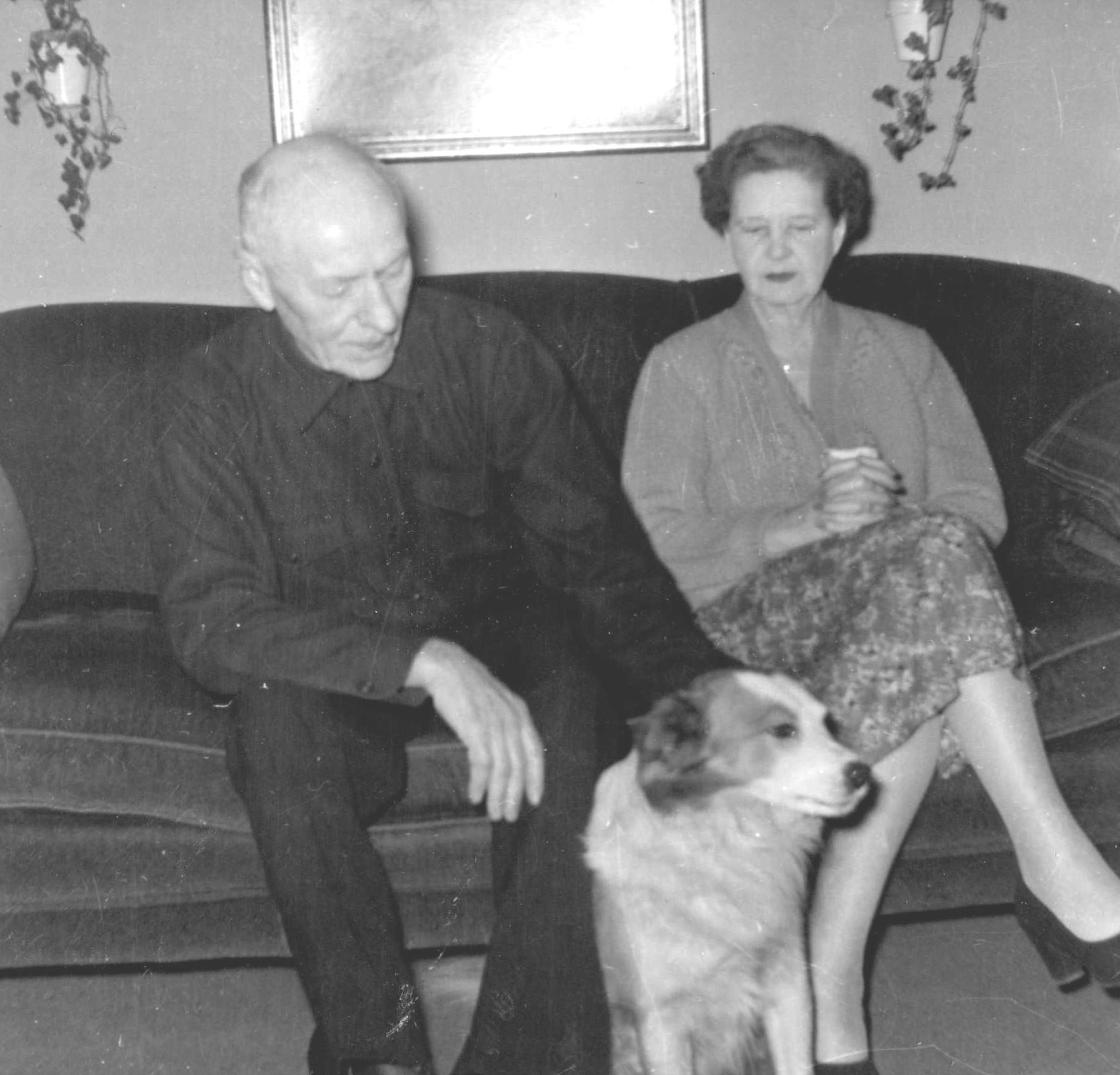
8 L. J. Wyckoff, “School Taxes,” Seattle Daily Times, March 21, 1932, page 6.
9 R. L. Polk, Seattle, Washington City Directory 1906; AncestryLibrary, https://www.ancestrylibrary.com
(accessed March 24, 2021), Charles E. Congleton and Luther J. Wyckoff.
10 1910 United States Census, Seattle Ward 7, King, Washington, population schedule, page 5A, dwelling 89, family 100, Luther J. Wyckoff; digital image,
AncestryLibrary, https://www. ancestrylibrary.com (accessed March 24, 2021). Also, 1920 United States Census, Seattle, King, Washington, population schedule, page 13B, dwelling 300, family 331, L. J. Wycokoff [sic]; AncestryLibrary, https://www. ancestrylibrary.com (accessed March 24, 2021). 1930 United States Census, Seattle, King, Washington, population schedule, page 4B, Luther J. Wyckoff; AncestryLibrary, https://www. ancestrylibrary.com/ (accessed March 24, 2021).
11 King County Marriage Records, 1855-Present, marriage record for Luther J. Wyckoff and June Lee McKay; Washington State Archives, Digital Archives, https://www.digitalarchives. wa.gov/Record/View/1A8FC63A71A
80D55A3A613791F190D35 (accessed January 19, 2021).
12 Emmy Fairfield, letter to the author, March 10, 2021.
13 L. J. Wyckoff, “Producing Lavender Oil in the Puget Sound District,” Herb Grower Magazine, 1951, vol. 5, no. 3, page 67.
14 L. J. Wyckoff and A. F. Sievers, “Lavender Growing in America,” The American Perfumer and Essential Oil Review, September 1935, reprint, unpaginated, second page.
15 Wyckoff, “Producing Lavender Oil,” page 68; Wyckoff and Sievers, “Lavender Growing,” September 1935, second page.
16 Wyckoff and Sievers, “Lavender Growing,” September 1935, first page.
17 Wyckoff, “Producing Lavender Oil,” page 68.
18 Rod Cook, email correspondence with the author, February 4, 2021.
19 Wyckoff and Sievers, “Lavender Growing,” September 1935, first page.
20 Wyckoff and Sievers, “Lavender Growing,” September 1935, first page.
21 Wyckoff, “Producing Lavender Oil,” page 71. Wyckoff and Sievers, “Lavender Growing,” September 1935, second page.
22 Wyckoff and Sievers, “Lavender Growing,” September 1935.
23 Wyckoff and Sievers, “Lavender Growing in America,” The American Perfumer and Essential Oil Review, October 1935, reprint, first page.
24 Wyckoff and Sievers, “Lavender Growing,” September 1935, third page.
25 Wyckoff, “Producing Lavender Oil,” page 72.
26 Wyckoff and Sievers, “Lavender Growing,” October 1935, first page.
27 Wyckoff, “Producing Lavender Oil,” page 72.
28 Cronk to Lacey Historical Society, December 21, 2020.
29 Cronk to Lacey Historical Society, December 21, 2020. Wyckoff, “Producing Lavender Oil,” page 79. Wyckoff and Sievers, “Lavender Growing,” October 1935, third page.
30 Wyckoff and Sievers, “Lavender Growing,” October 1935, second page.
31 “Marshal Chitty Sued Over Still,” Seattle Post-Intelligencer, November 3, 1934, page 3. “Chitty Must Pay $250 for Still,” Seattle Times, September 30, 1935, page 12.
32 Wyckoff and Sievers, “Lavender Growing,” September 1935, first page.
33 Wyckoff, “Producing Lavender Oil,” page 77.
34 Wyckoff and Sievers, “Lavender Growing,” October 1935, fifth page.
35 Plant Research Foundation Articles of Incorporation dated December 28, 1935, and Certificate of Dissolution, June 26, 1962; Secretary of State and Territory, Corporations and Trademarks, Non-Profit Corporations, 18851983, Washington State Archives.
36 Wyckoff, “Producing Lavender Oil,” page 78.
37 Wyckoff, “Producing Lavender Oil,” page 78.
38 1940 United States Census, Seattle, King, Washington, population schedule, page 2A, household 33, Luther and Jane Wyckoff; digital image, AncestryLibrary, https://www.ancestry
library.com (accessed March 24, 2021).
39 “Wyckoff,” obituary.
40 Fairfield to author, March 10, 2021.
41 Richard C. Bell, “A Sweet-Scented Farm: Lavender Oil is Olympia Man’s Crop,” Seattle Times, Sunday, November 16, 1947, page 2.
42 “Olympia Lavender Plant Grower Sends Cuttings to English Farm,” The Daily Olympian, undated clipping; Washington State Library Clipping File Agriculture.
43 “Lavender Experiment Flourishes,” The Daily Olympian, July 29, 1951, page 1.
44 United States Department of Agriculture, Soil Survey: Thurston County Washington, September 1958.
45 Tim Upton and Susyn Andrews, The Genus Lavandula (Portland, Oregon: Timber Press, 2004), page 40.
46 Wyckoff, “Producing Lavender Oil,” page 81.
47 L. J. Wyckoff, “Road to Socialism,” Seattle Daily Times, February 26, 1950, page 6.
48 Washington State Department of Agriculture, Thurston County Agriculture, Washington, 1958, page 32.
49 Statutory Warrant Deed between the Plant Research Foundation and the
Northern Pacific Railroad, September 9, 1960; Thurston County Government, Auditor, Deed Books, Volume 345, page 528; Washington State Archives.
50 Plant Research Foundation Certificate of Dissolution.
51 “Wyckoff,” obituary.
52 Thurston County Government, Assessor, Real Property Tax Assessment Field Books, 1970-1997, volume 50F, Washington State Archives.
53 Thurston County Fire District # 3 Commissioners, Resolutions, 19492010, Thurston County Fire District # 3 Fire Protection District 3, “Resolution No. 88,” April 8, 1971; Washington Digital Archives, https:// www.digitalarchives.wa.gov/Record/ View/FE1E1D40228118C311288613
C6C6E6CC (accessed March 5, 2021.)
54 Statutory Warrant Deed.
55 Fairfield to author, March 10, 2021.
56 Statutory Warrant Deed.
57 Fairfield to author, March 10, 2021.
58 Diane Huber, “12-Acre Lot Cleared of Trees for Future School,” The Olympian, September 11, 2008, page B1.
59 Wyckoff, “Producing Lavender Oil,” pages 78-79.
60 Upton and Andrews, The Genus Lavandula.
61 “A Flourishing Floral Story,” Yardley, London, website article, https:// www.yardleylondon.co.uk/a-flourish ing-floral-story (accessed January 29, 2021).
62 “Lavender farm,” GoogleMaps, https://www.google.com/maps/ (accessed March 24, 2021).
63 Office of the Secretary of State, Corporations Division, “Advanced Business Search,” https://ccfs.sos.wa. gov/#/AdvancedSearch (accessed March 24, 2021).
Mary Paynton Schaff was born and raised in Seattle, the daughter of two native Seattleites. She is twice over a graduate of the University of Washington with a degree in Creative Writing in 1998 and a Masters in Library and Information Science in 2003. For the last fifteen years, Mary has assisted researchers at the Washington State Library with information about the Pacific Northwest’s history, government, and genealogy; she currently serves as Northwest Librarian. Much to her own surprise, she resides in Tacoma with her husband, daughter and two dogs.
Art is an important part of a town’s history. It can record the community’s changing landscape. This is certainly true of the artist Edward Lange and Tumwater, Washington. Lange’s artwork of the late 19th/early 20th centuries depicted a prosperous Tumwater with river-based industries. There were also significant ties between the artist and the community.1
Edward Lange was born in Darmstadt, Germany in 1846. Later he moved to Long Island, New York. In 1871 he married Sarah Cornelia Denton and became an artist who drew Long Island farms, businesses, and communities. Then in 1889 Edward and his family came west to Olympia sensing economic opportunity on a booming frontier.
Establishing a home base in Olympia, Edward Lange traveled extensively, creating promotional art in South Puget Sound and throughout the Pacific Northwest until his death in 1912. His work, boosting businesses and communities, often appeared in publications of the time. Sadly, only a portion of Lange’s work (original art and print-
Artist Edward Lange, seen here circa 1905, was active in the Pacific Northwest during the late 19th/early 20th centuries. He had significant ties to Tumwater. Photograph courtesy of a private collection.

ed versions) survives to the present, but those pieces that remain are historical treasures.2
Tumwater, at the turn of the 19th/20th centuries, was a small town located where the Deschutes River entered the
southernmost point of Budd Inlet. Its population numbered 410 in 1890 and 490 in 1910. The community’s economy depended on Deschutes River industries. This included the Capital Brewing Company, established in 1896, which became the Olympia Brewing Company in 1902.3
The Capital Brewing Company/ Olympia Brewing Company was founded by Leopold Schmidt and owned by him until he died in 1914. Schmidt appears to have had a good working relationship with artist Edward Lange. Both Schmidt and Lange were German-American immigrants who had been born in 1846.4 While Schmidt came from Dorn Assenheim, Lange originated from Darmstadt. These communities are located in the State of Hesse (west-central Germany).
Fortunately, many business records of the Olympia Brewing Company have been preserved in the Schmidt House Archives of the Olympia Tumwater Foundation. These records include some fragmentary information on Lange’s ties to Leopold Schmidt and the brewery. Combined with contemporary newspaper accounts, some of the story can be told.
Featured in this circa 1905 photograph is Leopold Schmidt, founder and early owner of the Capital Brewing Company/Olympia Brewing Company. He seems to have had a good working relationship with fellow GermanAmerican Edward Lange. Photograph courtesy of the Brewmaster’s House Collection, City of Tumwater.
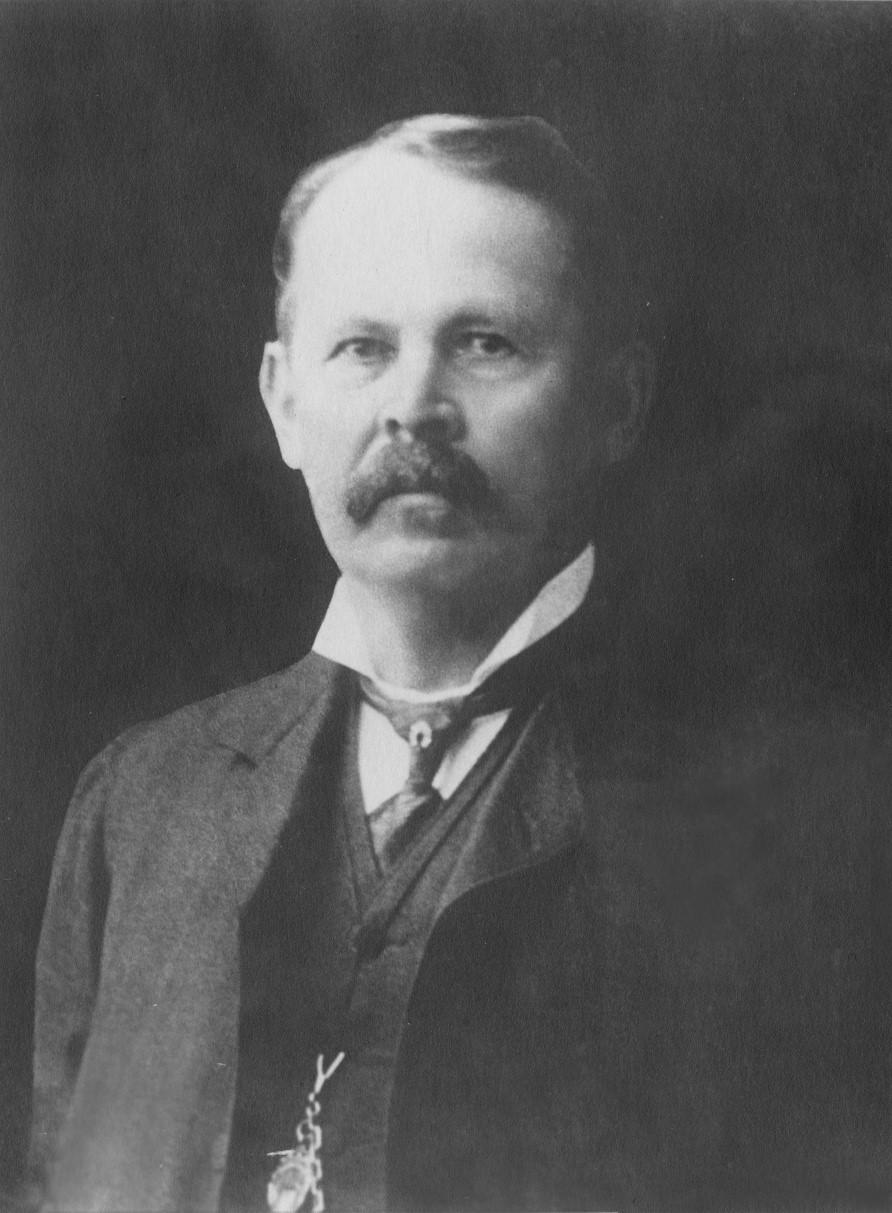
A cancelled check found in the Schmidt House Archives, dated January 3, 1898, was made out to “Edw. Lange” for $25. This check, from the Capital National Bank of Olympia, was signed by Leopold F. Schmidt. Edward Lange cashed it on January 4, 1898.5 Most likely the check was payment for artwork (now missing) by Lange.
Then a little more than a year later, on January 15, 1899, the Morning Olympian newspaper reported on a Lange painting: “The handsome painting of Tumwater falls and the plant of the
A cancelled check from Leopold Schmidt, dated January 3, 1898, was made out to Edward Lange. It probably represents payment for artwork created by Edward Lange for the Capital Brewing Company. Image courtesy of the Schmidt House Archives, Olympia Tumwater Foundation, Tumwater, Washington.

Capital Brewing company, on view in O’Connor’s window, is the work of Edward Lange.”6 Michael O’Connor owned a book and stationery store in Olympia from circa 1884 to 1914.
The painting at O’Connor’s store cannot now be located, but it very likely provided the image for a color lithograph of which at least one copy has survived. This copy is in the collection of the Beinecke Rare Book and Manuscript Library, Yale University, New Haven, Connecticut. It has the title of “TUMWATER, Near OLYMPIA, Wash. Presented by the Capital Brewing Co. 1899.” In a corner is printed the name of the lithograph’s publisher, “THE MILWAUKEE [M emblem] LITHO. & ENGR. CO. MILWAUKEE, WIS”.7 Though unsigned, the image shows all the stylistic elements of Edward Lange’s work.
The Capitol Brewing Company commissioned this 1899 lithograph. A letter, dated August 15, 1899, at the Schmidt House Archives sheds light on the production of the print by the Milwaukee Lithographing and Engraving Company. It was written by Peter Schmidt Sr. to his parents (Leopold and Johanna Schmidt), brothers and sister while on a brewery business trip to Milwaukee. In the letter Peter brings up the issue that the lithograph was being tinted yellow by the Wisconsin company:
I saw Mil. Litho. [Milwaukee Lithographing and Engraving Company] and signed your letter, but added ‘with understanding that those were the colors you ordered.’
In 1899 the Milwaukee Lithographing and Engraving Company of Wisconsin produced this print for the Capital Brewing Company. It was based on an Edward Lange drawing. Image courtesy of the Beinecke Rare Book and Manuscript Library, Yale University, New Haven, Connecticut.

They will settle the matter satisfactorily and are willing to do it. They will write to you. These people are not at all beasts in my mind. It was not possible to make the litho. in the colors you wanted, but as I told them that ‘rotten yellow background’ and poor waterfall spoiled it. I was not all pleased with the cards,
but approved of them as you were in such a hurry for them and they were so long in getting them out. In regard to the Lith. of the Brewery, the size always means the paper not the picture but they make a lower price on them to settle the affair. They will let you know if the stone is large enough, maybe if you want to
they could put in the new bottle house according to a sketch you might send and therefore by making the paper about an inch longer sideways get a better effect.8
The surviving copy of the original 1899 lithograph is still tinted yellow. However, a later reprint (perhaps done in the 1970s) lacks the yellow background.9 In either case, the Lange image depicts in detail how the Capital Brewing Company looked on the cusp of the 20th century. It seems to have an air of serene prosperity.
In 1901 there are several references to Lange’s artwork associated with Leopold Schmidt and the Capital Brewing Company. The Washington Standard newspaper of Olympia on February 15, 1901 described “A Magnificent Picture” on public display:
“Mr. Lang [Lange], the well-known Olympia artist, has just completed an oil-painting representing the Capital Brewery and its surroundings, at Tumwater. The picture is mounted in a gilt frame about eight feet long and five feet wide, and at present it is hanging in the lobby of Hotel Olympia. The painting is not only a living epistle of Mr. Lang[e]’s skill but its details are so perfect that the beholder may well fancy that he is standing within a stone’s throw of one of the finest brewing and mineral water plants on the Pacific Coast as now operated by our townsman, Leopold F. Schmidt.”10
Unfortunately, this large painting has long since disappeared. The Hotel Olympia was a community landmark located on Main Street (now Capitol Way) between 7th and 8th Avenues. Built in 1890, the building burned in a massive 1904 fire.11
On September 30, 1901, an entry in the Olympia Brewing Company Cash Journal indicates that the brewery purchased a number of Lange paintings and placed them in its Furniture & Fixtures section. The entry reads as follows:
Monday, Sept. 30, 1901
$166.85
Furniture & Fixtures
Advertising a/c
3 oil paintings by Lange
2 @ 40.00 each
1 @ 50.00 130.00
Framing
1 at B [illegible] 17.35
”one14.30
Map Washington 5.50
We transfer these to Fur and Fix [Furniture and Fixtures] as part are there and we want to have them all together and because they are fixtures.12
Furthermore, a statement of assets for the Capital Brewing Company, dated October 1, 1901, lists six oil paintings by “Mr. Ed Lange” at $40.00 each and one oil painting by “Mr. Ed Lange” at $50.00.13 None of these paintings can
be located now. The discovery of even one would be a remarkable historical find.
Edward Lange’s relationship with the Olympia Brewing Company and Leopold Schmidt very likely preceded 1898 and continued past 1901, but this is undocumented. In any case, Lange did do a considerable amount of Tumwater artwork which survives but cannot now be directly connected either to the brewery or Schmidt.
Lange’s surviving Tumwater work can be divided into several categories. The first category consists of pictures that include the town on the Deschutes River as part of larger South Sound
panoramic views. Usually, the Tumwater section in such artwork is fairly small and lacks details.14
One drawing in this category, however, has an unusually interesting and detailed view of the town and Deschutes River. The illustration, signed by Lange, appeared in Russell & Russell’s circa 1893 Olympia on the Sound booklet. Titled “OLYMPIA, THE CAPITAL OF THE STATE OF WASHINGTON,” the sepia-colored picture shows a bird’s eye view (a panoramic view as a bird would see from a great height) of South Puget Sound. Tumwater, in the lower left corner of the image, is depicted in detail as an orderly community of businesses and homes focused on the river.15
The Tumwater section of Edward Lange’s “OLYMPIA, THE CAPITAL OF THE STATE OF WASHINGTON” reveals an imaginative view of the community on the Deschutes River. It was published in Russell & Russell’s circa 1893 Olympia on the Sound booklet. (The vertical line toward the right side of the image is a string used for binding the booklet.) Image courtesy of the Washington State Library.
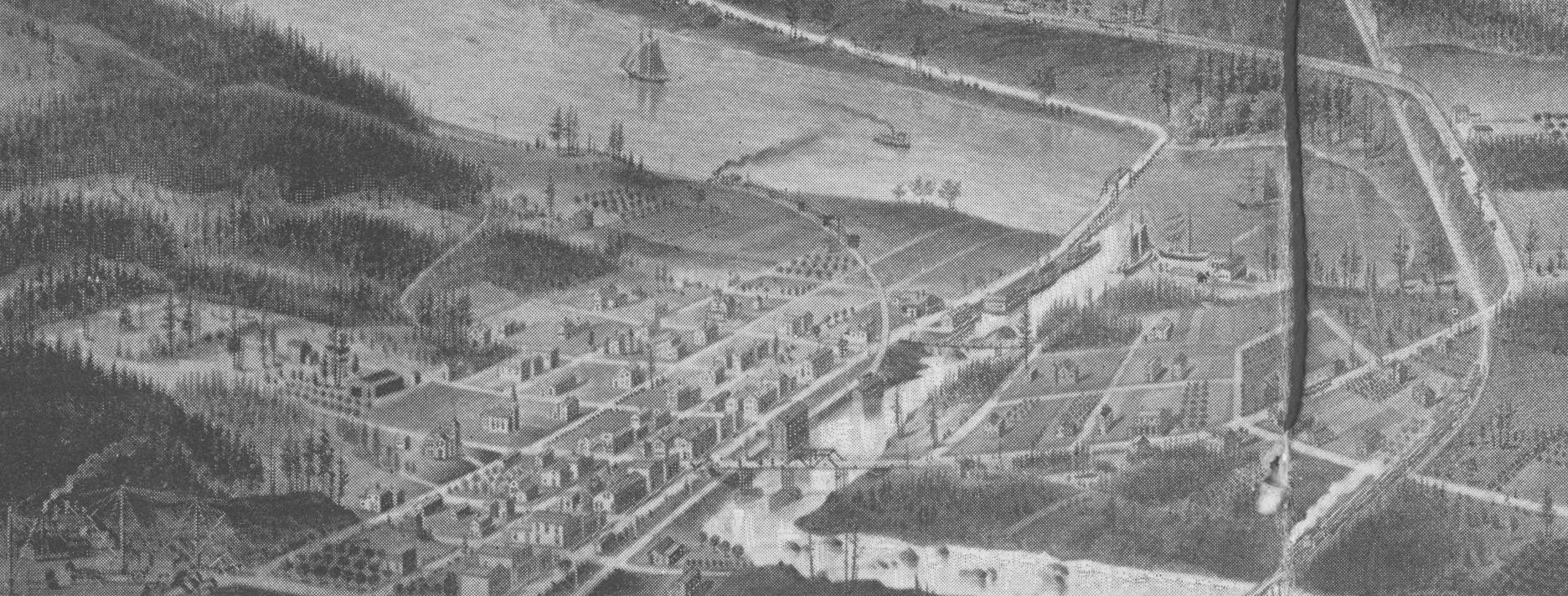
water surviving artwork includes vignettes which feature Tumwater scenes. These vignettes are small separate Lange drawings that were sometimes associated with larger Lange pictures. The “Olympia, W.” image, circa 1891, sometimes appears with vignettes surrounding the central panoramic scene of Olympia viewed from the town’s Westside. For example, a black-and-white version published in Hazard Stevens’ 1891 Olympia booklet has five vignettes, including one of the Middle Falls area of the Deschutes River in Tumwater. It depicts the
Olympia Light & Power Company electric plant found at that location.16
Another Lange vignette of a Tumwater scene is on the green-colored cover of the May 1891 “Tribune Souvenir of Olympia, Washington.” This special newspaper section published by the Olympia Tribune promotes the businesses and people of the area. The cover art, signed by Lange, has numerous vignettes surrounding a central circular panoramic view of South Puget Sound looking north. The Tumwater vignette shows industries clus-
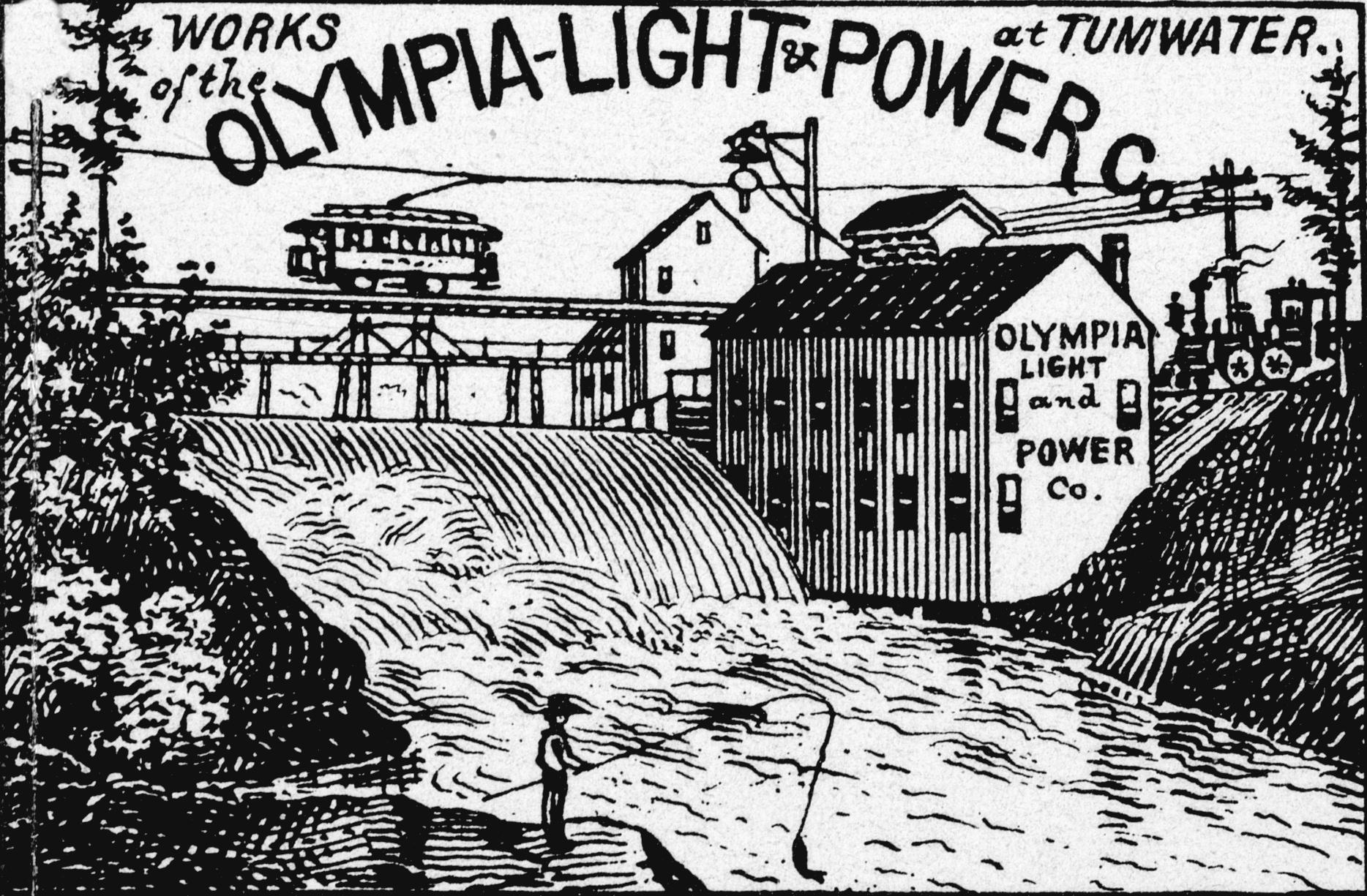
tered around the Deschutes River’s Middle Falls.17
A third example of a Tumwater vignette by Lange is on the circa 1893 sepia-colored “Olympia, Capital of the State of Washington” print, which consists of a large central panoramic view of Olympia from the Westside surrounded by vignettes. The Tumwater vignette is especially well done, depicting the Olympia Light & Power Company electrical plant at the Middle Falls. There is even a young man trying his luck fishing in the river.18
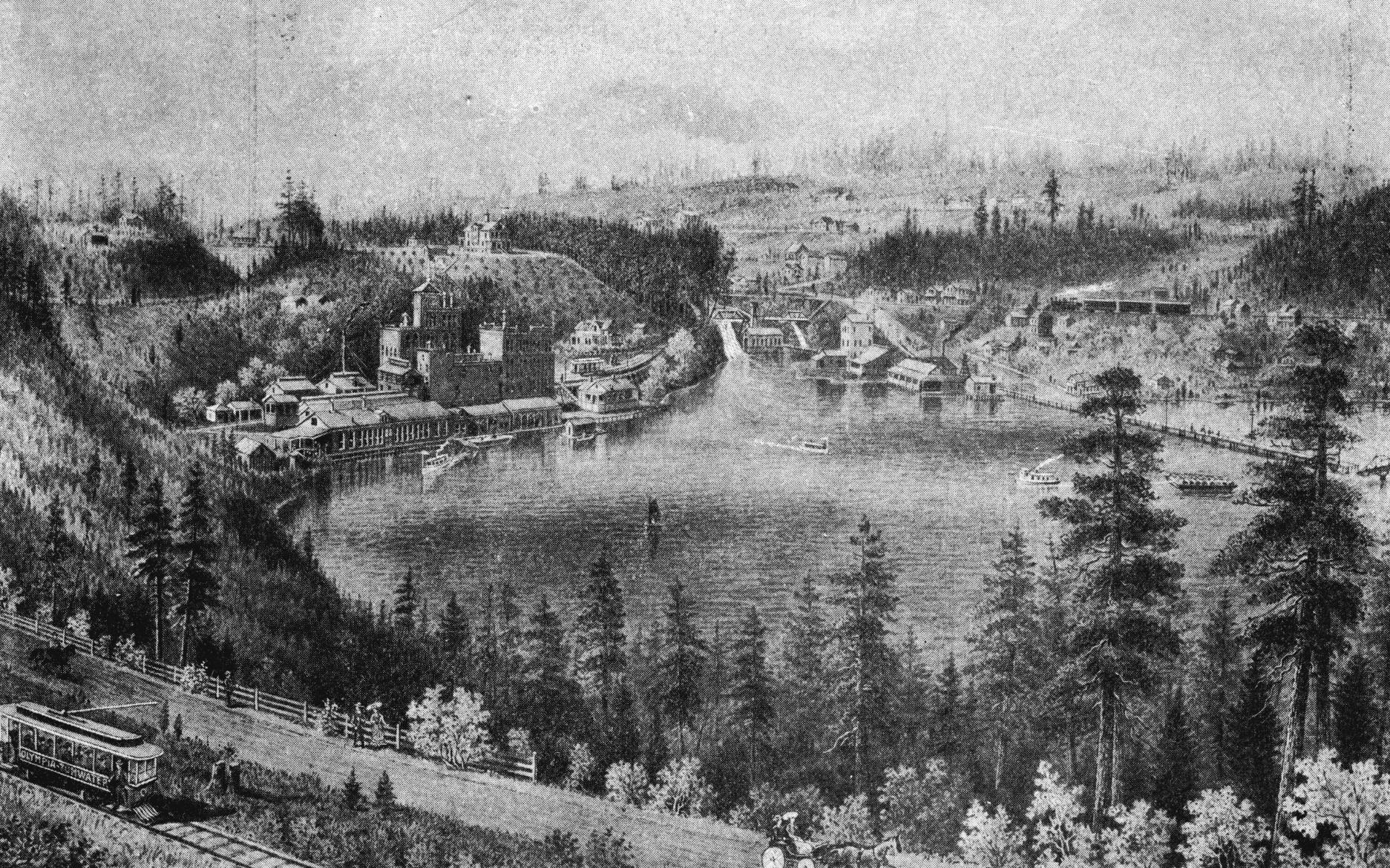
A fourth case of a Lange vignette of a Tumwater scene can be found on the 1903 black-and-white print titled “OLYMPIA, THE CAPITAL ON PUGET SOUND, WASHINGTON . . .” The print, signed by Lange, has numerous vignettes circling the central panoramic view of Olympia as seen from the Westside. One vignette shows the lower “Tumwater Falls,” but also includes the Middle Falls area.19
The third (and last) category of Lange’s surviving Tumwater artwork is made up of pictures that completely focus
on the community beside the Deschutes River. Only three items have been found so far for this group, but hopefully more will be discovered in the future. One, the 1899 lithograph of the Capitol Brewing Company, has been discussed above.
Another Tumwater picture by Lange appeared in the circa 1905 Olympia Chamber of Commerce publication, Olympia: The Capital City Of The State Of Washington And The Seat Of Government Of Thurston County. Lange’s black-and-white illustration in the booklet was captioned “Plant of the Olympia Brewing Co., Located at the Extreme Head of Budd’s Inlet”.20 Though not signed by the artist, it displays the classic Lange style.
In this 1904 to early-mid-1905 image, the viewer is floating above a bluff looking down on the Budd Inlet estuary and Tumwater (including the Olympia Brewing Company, other industries, Tumwater Falls, and homes). The foreground area is busy with a streetcar, horse and buggy, man on horse, and pedestrians.
Interestingly, the brick brewhouse of the Olympia Brewery is pictured on the originally planned site to the south. However, workers attempting to lay the foundation found the area unsuitable so they moved the site to the north where they could reach bedrock. Lange’s image thus shows planned construction that was changed by reality. On the hill behind the brewery plant is the Schmidt House, the home of Leopold Schmidt and his family.
A third Lange picture of Tumwater is not signed by the artist. It again has the viewer above a bluff peering down on Budd Inlet, the brewery, and community. This time the foreground area features a streetcar, horse and buggy, pedestrians, and an automobile. The brewhouse complex is now depicted as built. The Schmidt House is on the hill behind the brewery. Also on the hill, surprisingly, is a Swiss chalet. The chalet, which was the Olympia Brewing Company pavilion at the 1905 Lewis and Clark Exposition in Portland, actually did not come to Tumwater after the fair, but was set up in Olympia’s Priest Point Park. In the 1960s the building was torn down.21
This late-1905 image appeared in several forms. An original black-andwhite photograph of the picture survives in a private collection. In the lower left corner of the photograph’s background card is printed “Loryea Spokane, Wash.”22 Milton I. Loryea was a Spokane photographer active between 1893 and 1912. So it seems clear that this Lange picture was available outside the South Puget Sound region.
Furthermore, this drawing of Tumwater proved a popular illustration for postcards. Various Olympia businessmen (Winstanley & Blankenship, A. L. Kreider, and N. C. Davis) published circa 1907–1910 postcards with a cropped black-and-white version of the image.23 These cards were actually printed in Germany, a major center of postcard production before World War I. In addition, Edward M. Mitchell of
San Francisco, California, published and printed around the same time another postcard version of the image, cropped even more to focus on the Olympia Brewery. This version appeared in color.24
Finally, Edward Lange and his wife Sarah Denton Lange were both buried in Tumwater cemeteries. This is not surprising since nearby cemeteries for
Olympia’s residents, except Forest Funeral Homes’ Cemetery, are outside the capital city. Still it is another tie between the artist and Tumwater. Sarah Denton Lange died in Olympia on September 12, 1897 and was buried in Calvary Cemetery, a Catholic cemetery in Tumwater near Littlerock Road SW. Her burial site is marked by a gravestone.25
Edward Lange died on July 20, 1912 in Olympia, and was laid to rest in

Tumwater’s Masonic Cemetery (on present-day North Street SE). His grave has no marker.26 Perhaps the practical artist did not want money spent on a gravestone, instead desiring to pass on his estate without “frivolous” expenses to his children (who from all accounts were close to him).
In conclusion, surviving records, newspapers articles, and artwork indicate that artist Edward Lange had sig-
nificant ties to Tumwater at the turn of the 19th/20th centuries. Edward and his wife Sarah are even buried in that community. The artist represented in his artwork a thriving town centered on industries associated with the Deschutes River. The Capital/Olympia Brewing Company is especially featured, perhaps partly because of a good working relationship between Leopold Schmidt and Lange, but certainly reflecting the economic importance of the brewery.
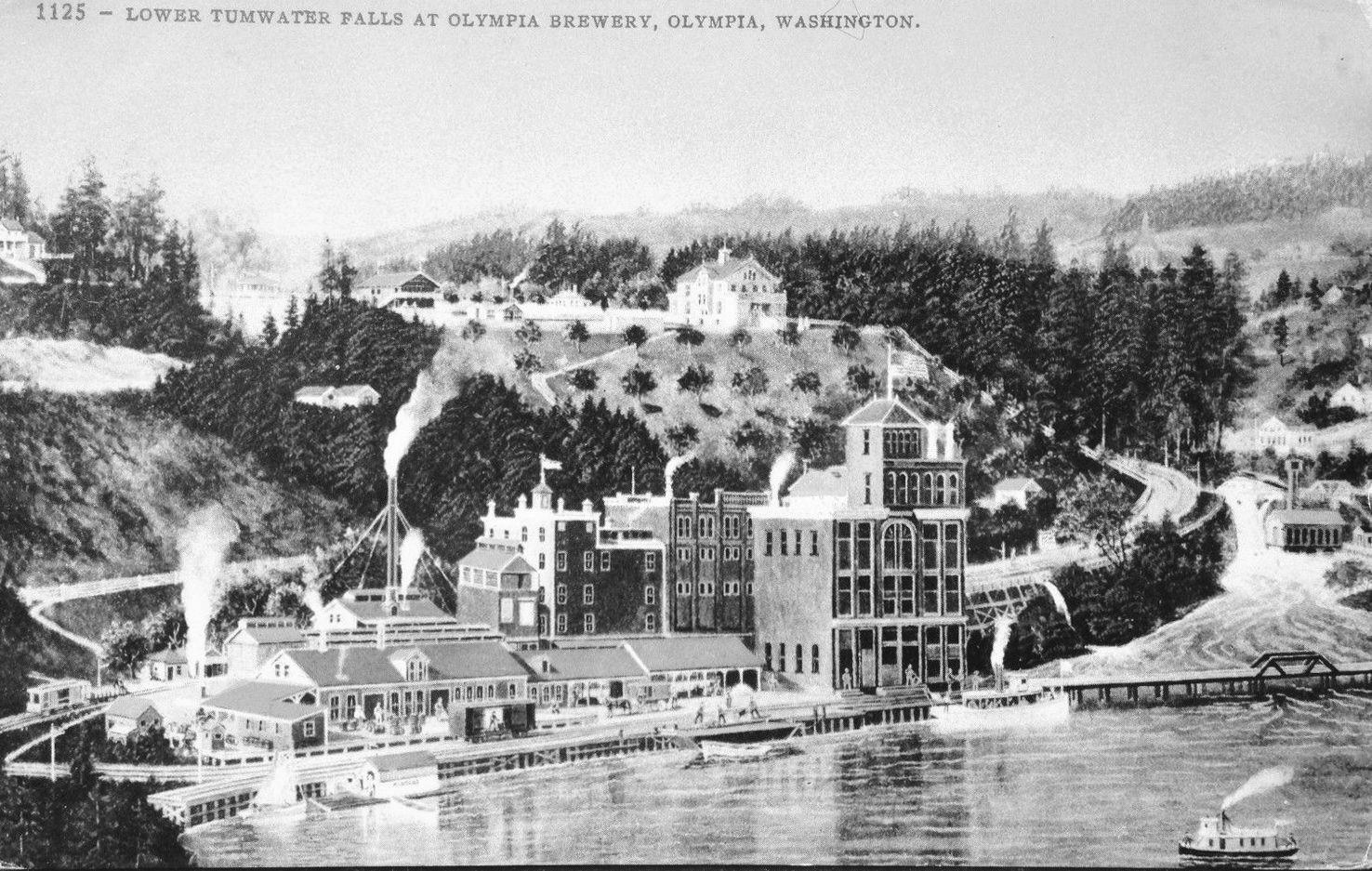
Various black-and-white postcards were published around 1907-1910 with a cropped version of Edward Lange’s circa 1905 drawing of the Olympia Brewing Company and Tumwater. This example, published by Winstanley & Blankenship and postmarked July 26, 1907, has a building sketched in to the right and below the powerhouse (on the right side). Image courtesy of the Schmidt House Archives, Olympia Tumwater Foundation, Tumwater, Washington.
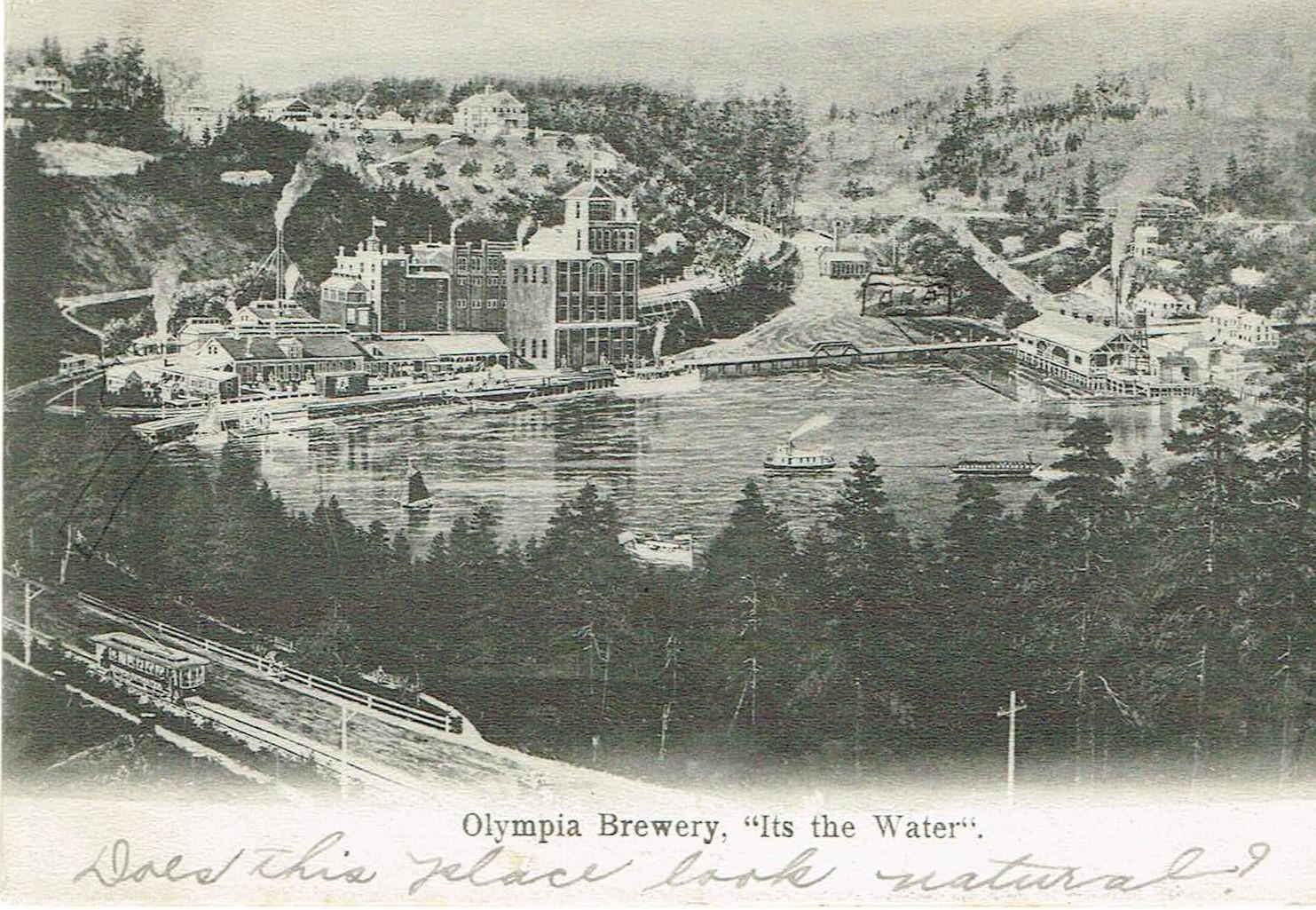
torical gems that inform us about life in the past. Hopefully, more Lange images will be discovered in the future. Still other questions come to mind: are artists today recording the changing face of current Tumwater (and other communities)? And is their work being preserved for future generations to enjoy and learn from?
This article could not have been written without the assistance of other people. I especially thank Karen Johnson, Curator of the Schmidt House, Olympia Tumwater Foundation, who provided invaluable historical information and access to Lange-related items in the Schmidt House collection.
My thanks also go to the helpful staff of the Washington State Library, a rich source of knowledge about regional history and art. Finally, I thank my family for their steady support and encouragement of my historical endeavors.
possession of the author, seems to indicate that the two men were relatives. Genealogists researching the Schmidt family, however, have found no evidence of genealogical ties between the two individuals.
1 Though the artist lived in Olympia, a local newspaper once identified him as “Edward Lange of Tumwater.” “Painting Of Miramar. The New Orchard Subdivision on Eld Inlet,” Morning Olympian, March 4, 1894, page 4.
2 More information about the life and art of Edward Lange can be found in Drew W. Crooks, Edward Lange: An Early Artist of Olympia and Washington State (Olympia, Washington: Tenalquot Press, 2012).
3 For additional information on the Capital/Olympia Brewing Company, see Karen L. Johnson, “It’s The Water: The History of the Olympia Brewing Company,” in Sandra A. Crowell & Shirley A. Stirling, editors, Thurston County: Water, Woods & Prairies: Essays on the History of Washington’s Capital County (Olympia, Washington: Thurston County, 2019), pages 177183.
4 Furthermore, one historian thought Leopold Schmidt and Edward Lange might have been related. Delbert McBride (curator at the Washington State Capitol Museum from 1966 to 1982) in circa 1979 notes, now in the
5 Leopold F. Schmidt, cancelled check written to Edward Lange, January 3, 1898; Cancelled Checks, 1897-1905, Leopold F. Schmidt Papers, Box 3, Schmidt House Archives, Olympia Tumwater Foundation, Tumwater, Washington.
6 “Brevities Of The Day,” Morning Olympian, January 15, 1899, page 3.
7 Edward Lange, “TUMWATER, Near OLYMPIA, Wash. Presented by the Capital Brewing Co. 1899,” tinted lithograph; Folder 1171, Fred R. and Kathryn M. Stenzel Collection of Western American Art, Series IV, Box 62, Beinecke Rare Book and Manuscript Library, Yale University, New Haven, Connecticut.
8 Letter from Peter Schmidt to Leopold Schmidt family, August 15, 1899; folder: Leopold F. Schmidt Correspondence, 1899, in Leopold F. Schmidt Papers/Correspondence, 1862-1910, Box 4, Schmidt House Archives, Olympia Tumwater Foundation, Tumwater, Washington.
9 The author possesses a copy of the reprint version that has been decoupaged to a wooden board.
10 “A Magnificent Picture,” Washington Standard, February 15, 1901, page 3.
11 For more information about the Hotel Olympia, see Jennifer Crooks, “Fame and a Fiery End: The Hotel Olympia,” ThurstonTalk.com, December 17, 2017, https://www. thurstontalk.com/2017/12/17/fame-fiery-endhotel-olympia/ (accessed August 8, 2020).
12 [Capital Brewing Company/] Olympia Brewing Company Cash Journal, 1900-1903, September 30, 1903, page 75; Schmidt House Archives, Olympia Tumwater Foundation, Tumwater, Washington.
13 Capital Brewing Company Statement of Assets, Trial Balance, 1901; Olympia Brewing Company Financial Records, Box 6, Schmidt House Archives, Olympia Tumwater Foundation, Tumwater, Washington.
14 For example, see the central panoramic scenes in three images signed by Edward Lange: the circa 1891 “Olympia, W.” (which appeared in different formats, including several sepia-toned original photographs of the drawing at the Washington State Historical Society, Tacoma); the circa 1893 sepia-colored print “Olympia, Capital of the State of Washington” (of which a copy is preserved at the Washington State Library, Tumwater); and the 1903 black-and-white print “OLYMPIA, THE CAPITAL ON PUGET SOUND, WASHINGTON . . .” (of which a copy is kept at the Library of Congress, Washington, DC). Incidentally, all three images are accompanied by vignettes, including a vignette of a
Tumwater scene. It should be noted that in the case of “Olympia, W.,” the vignettes do not appear in the original photographs, but only in certain printed versions, such as Hazard Stevens, Olympia (Boston, Massachusetts: Stevens, 1891). A copy of the booklet is at the Washington State Library. These Tumwater vignettes are discussed in this article’s second category of Lange’s Tumwater artwork.
15 Russell & Russell, Olympia on the Sound (Chicago, Illinois: Russell & Russell, circa 1893), unnumbered pages in center of booklet. A copy is in the Washington State Library.
16 Stevens, Olympia, opposite page 4.
17 “Tribune Souvenir of Olympia, Washington,” Olympia Tribune, May 1891, front cover. A copy of the special newspaper section is at the Washington State Library.
18 “Olympia, Capital of the State of Washington” (Olympia, Washington: State Printing and Publishing Company, 1893), print. Among the advertisements (with no illustration) on this print is a Tumwater-related one: “GELBACK and SCOTT, DEALERS in CHOICE RESIDENCE PROPERTY at the TUMWATER FALLS. WE ALSO HAVE FOR SALE VERY DESIRABLE PROPERTY ALONG THE OLYMPIA & TUMWATER ELECTRIC LINE. CALL ON OR ADDRESS at TUMWATER, Wash.”
19 Edward Lange, “OLYMPIA, THE
CAPITAL ON PUGET SOUND, WASHINGTON . . .” (Chicago, IL: Franklin Engraving & Electrotyping Company, 1903). The Tumwater vignette on this lithograph was called “a glimpse of Tumwater” in a 1903 newspaper article describing the Lange print. “City News In Brief,” Washington Standard, May 8, 1903, page 3.
20 Olympia Chamber of Commerce, Olympia: The Capital City Of The State Of Washington And The Seat Of Government Of Thurston County (Olympia, Washington: Recorder Publishing Company, circa 1905), page 48. A copy of the booklet is in the collection of the Washington State Library. Lange’s Tumwater image in this booklet was also published in various newspapers from 1905 to 1912: Morning Olympian, April 23, 1905, page 6; The Republic (Wenatchee, Washington), October 26, 1905, page 3; Olympia Daily Recorder, August 15, 1906, page 2; Olympia Daily Recorder, May 1, 1907, page 3; Olympia Daily Recorder, February 20, 1911, page 5; and Olympia Daily Recorder, November 8, 1912.
21 For more information on the history of this Swiss chalet, see Drew Crooks, “The Olympia Brewing Company’s Swiss Chalet,” Olympia Tumwater Foundation Blog, https:// olytumfoundation.org/2015/12/theolympia-brewing-companys-swisschalet/ (accessed August 18, 2020).
22 Original photograph by Milton I. Loryea of Lange’s untitled drawing of Olympia Brewing Company and Tum-
Sarah Denton Lange, Edward’s wife, died on September 12, 1897 at the Lange home in Olympia, and was laid to rest in the Calvary [Catholic] Cemetery in Tumwater. Photograph courtesy of Steve Willis.
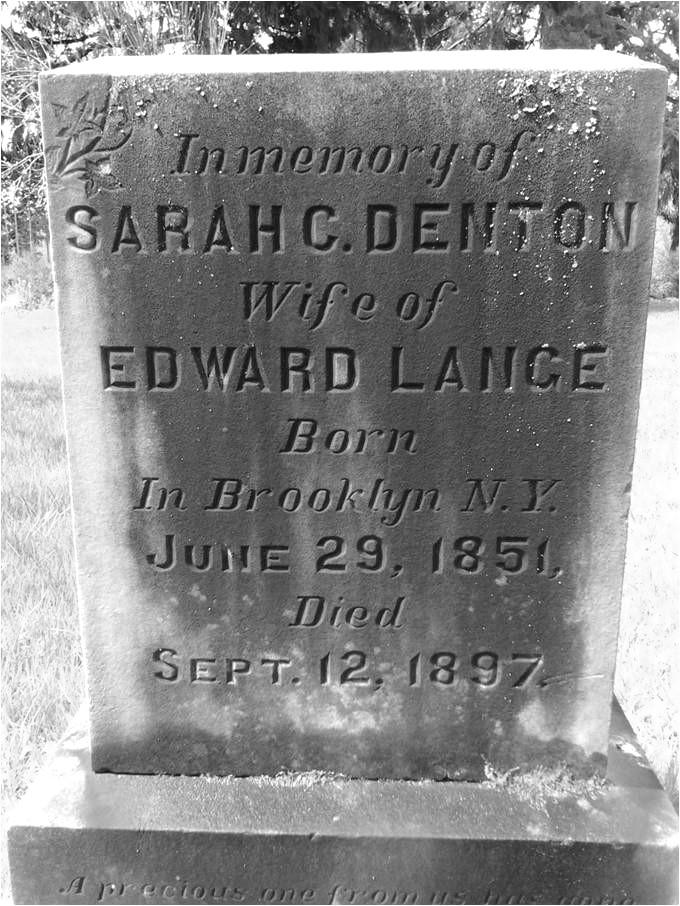
water, circa 1905, private collection.
23 An example of the Winstanley & Blankenship postcard with the Lange image is in the postcard collection of the Schmidt House Archives, Olympia Tumwater Foundation, Tumwater, Washington. A “Mrs. A. M. S.” sent the card to Adolph Schmidt. It was postmarked July 26, 1907.
24 “1125 – LOWER TUMWATER FALLS
AT OLYMPIA BREWERY, OLYMPIA, WASHINGTON.,” color postcard (San Francisco, California: Edward M. Mitchell, circa 1907-1910). Copies of this card are in the Washington State Historical Society (Tacoma, Washington) collection and private collections.
25 Visits by author to Calvary Cemetery, Tumwater, 2012 and 2020. The gravesite of Sarah Cornelia Lange in Calvary Cemetery is noted in: Tumwater Henderson House Museum Volunteers in association with Tumwater Historic Preservation Commission, City of Tumwater: Tumwater Cemeteries Census Report, Compiled November 1995 (Tumwater, Washington: City of Tumwater, Henderson House Museum, 1995), page 13.
26 Visits by author to Masonic Cemetery, Tumwater, 2012 and 2020. Wal-
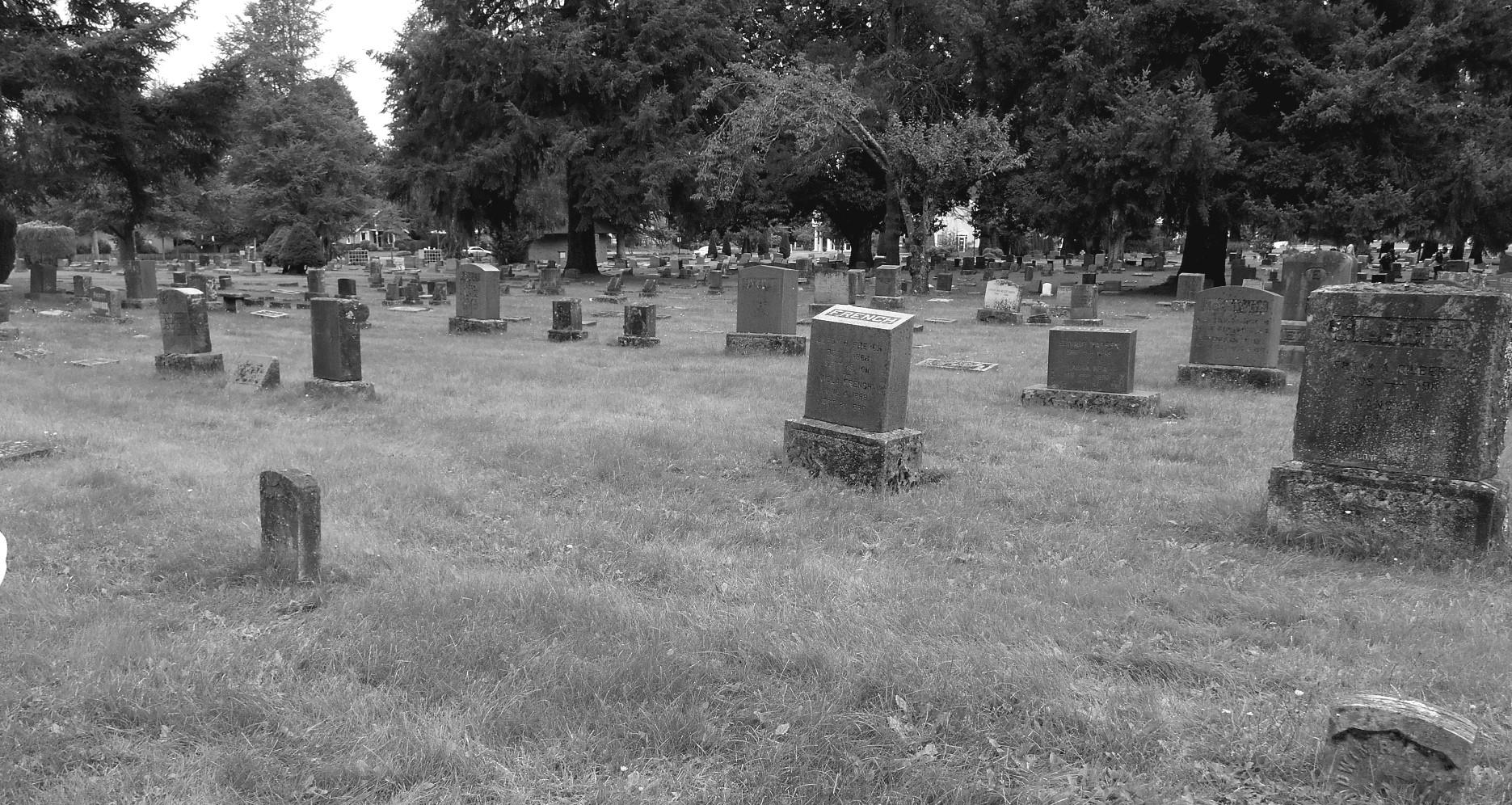
Magnolia Lange and grandson of Edward Lange, died in 1915 at the age of eight months. He was buried in the same cemetery lot as Edward who died in 1912 (Masonic Cemetery Records, undated). There are no markers for either grandson or grandfather.
Drew W. Crooks graduated with a bachelor’s degree in history and anthropology and a master’s degree in museology (museum studies) from the University of Washington. For over 30 years he has worked with museums in the South Puget Sound region, written articles and books on area heritage, and presented history talks to school classes and community groups. Drew finds the relationship of late 19th/early 20th century regional artists, such as Edward Lange, with their communities an especially interesting research sub-
“A civilian who knowingly risks his or her own life to an extraordinary degree while saving or attempting to save the life of another person.” Such is a hero, as defined by the Carnegie Hero Fund, established in 1904 by industrialist and philanthropist Andrew Carnegie.

The Carnegie Hero Fund Commission maintains a website that explains the history of the program, and chronicles the heroism of every individual who has received a Carnegie medal since the project’s inception. A list of award recipients may be searched by name, city or state of residence, date of act, or type of act.
Seven Thurston County residents have received a Carnegie medal, and their individual stories are told below, following a brief background on the medal program itself.
Coal mining has always been a dangerous occupation. Cave-ins, explosions, deadly gas, black lung disease all these and more lay in wait for men trying to earn an honest living for themselves and their families.
On a cold Monday morning in 1904, the Harwick Mine outside of Pitts-
burgh, Pennsylvania was off to the start of another workweek. Nearly the entire workforce of miners was already laboring deep underground, when a dynamite detonation ignited a pocket of methane gas near the mine’s entrance. The explosion created a great cloud of dust which itself ignited, generating a chain reaction which “caused the complete explosion of the entire mine.”1
The community and mine owner Allegheny Coal Company launched immediate and extensive rescue operations, but the explosion was so widespread and severe that only one miner survived out of nearly 180 men involved. Added to the death toll were two selfless individuals who gave their lives while attempting to save others.
“Selwyn M. Taylor, 42, of Pittsburgh, an eminent mining engineer, responded to Harwick within hours. After arranging for repair of a ventilation fan, he and a rescue party descended the main shaft at 6 p.m. They found one man alive at the bottom of the shaft. Adolph Gunia, 17, severely burned, was the disaster’s sole survivor. Believing that others might be alive, Taylor advanced farther into the mine but was overcome by ‘afterdamp,’ an asphyxiating gas, the byproduct of the explosion. He died early the next day, leaving a widow and stepson.”2
“Coalminer Daniel Lyle, 43, of Castle Shannon, PA, was staying near Leechburg, PA, when he answered an appeal for rescue workers, responding to the mine the day after the explosion. From the Pittsburg Press of January 27, 1904: ‘(Lyle) worked yesterday afternoon and most of the night in the mine with the rescue party . . . he went into the mine before daybreak this morning and started to prepare the bodies to be brought up on the cage. While out in the mine farther than the others of the party, in search for more (miners), Lyle was overcome with afterdamp . . . The accident cast a decided gloom upon the rescuing
party . . . Lyle made a valiant effort to rescue entombed men. He left a widow and five children. What a tragedy that his life had to go with his deed! He was a hero.”3
In all, 177 miners died, in addition to Taylor and Lyle, classing Harwick among the ten deadliest mine disasters in U.S. history.
Andrew Carnegie had very humble beginnings in Scotland, but gradually worked his way up the proverbial ladder after he and his parents immigrated to Pennsylvania in 1848. He eventually made a fortune through hard work, good luck, and smart investments in railroads, telegraphy, and steel. By the late 1800s, Carnegie had amassed what would be several billion dollars in today’s money, and proceeded to give much of it away. He is well known for his funding of public libraries across the U.S.; many of these buildings still exist and are known appropriately as Carnegie libraries. (Olympia has its own Carnegie library building at 620 Franklin Street SE.)
Andrew Carnegie was profoundly affected by the Harwick disaster and the men who died trying to rescue the victims. In response to the tragedy, Carnegie felt compelled to establish a fund for those who risked their lives to save others, and thus the Carnegie Hero Fund Commission was born.
Carnegie endowed the fund with $5 million (over $144 million in today’s
The obverse and reverse of the Carnegie medal, a bronze disk three inches in diameter. The reverse is personalized with the recipient’s name and a brief description of the heroic act, date, and location. This particular medal was awarded posthumously to Joseph Alongi of Yelm. Photograph by author.


dollars). He charged the 21-member commission “with honoring whom he called the ‘heroes of civilization,’ whose lifesaving actions put them in stark contrast to the ‘heroes of barbarism, (who) maimed or killed’ their fellow man. That the mission of the Hero Fund as set forth by Carnegie is unchanged over more than a century, despite massive upheaval in the social and world order, is testament both to his foresight and to essentially unchanging human nature.”4
“The Commission’s working definition of a hero as well as its requirements for awarding remain largely those that were approved by the founder. The candidate for an award must be a civilian who voluntarily risks his or her
life to an extraordinary degree while saving or attempting to save the life of another person. . . . There must be conclusive evidence to support the act’s occurrence, and the act must be called to the attention of the Commission within two years. Those who are selected for recognition by the Commission are awarded the Carnegie Medal, and they, or their survivors, become eligible for financial considerations, including one-time grants, scholarship aid, death benefits, and continuing assistance. . . . About 20 percent of the Medals are awarded posthumously.”5
Since its inception, the Carnegie Fund
“has awarded more than 10,000 medals and about $40 million in accompanying grants” in the U.S. and Canada. Carnegie also endowed funds in Great Britain, France, Germany, Norway, Switzerland, the Netherlands, Sweden, Denmark, Belgium, and Italy.6
Included in the impressive total of Carnegie medals awarded in the U.S. are seven Thurston County residents. All risked their lives to save another; some made the ultimate sacrifice during their act of courage. Their stories of heroism follow.
On January 5, 1958, Joseph Alongi, 44, a Yelm restaurant owner, and Robert Ellis, 38, a Yelm tavern owner, and both members of the Yelm Volunteer Fire Department, made a daring rescue attempt on the Nisqually River.
That day, three Pierce County men decided to go fishing on the river. Robert Parker, a resident of Fort Lewis, and Bob McDaniel and Ted Stransby, both of Spanaway, launched a small fishing boat which soon capsized, and all three men were “thrown into turbulent water seven feet deep, from where they climbed onto a boulder rising two feet above the surface 100 feet from the bank. McDaniel held Parker, who could not swim, on the boulder, while [Stransby] with difficulty swam to the bank, made his way to a farmhouse a mile away, and summoned help.”7
when the call for help came.8 The Carnegie Hero Fund website tells the rest of the story.
“Volunteer firemen, including Alongi, started to the aid of the stranded men, and a helicopter was dispatched from [McChord] air base 28 miles away. From the farmhouse a group of firemen set out on foot to locate McDaniel and Parker. Alongi, who had been delayed while obtaining his 12-foot boat, then arrived at the farm with Robert W. Ellis, a friend who had agreed to help. Alongi, who was experienced at handling small craft but could not swim, and Ellis launched the boat in the river and proceeded to a gravel bar 100 feet upstream from McDaniel and Parker.
“Meanwhile the water had risen two feet following the opening of the gates of a power dam upstream from the rapids. McDaniel, standing on ledges of the boulder, then was in water nearly hip-deep as he held Parker on the rock to prevent him from being carried away by the current of eight miles an hour. Unable to hear McDaniel's warning shouts above the roar of the water, Alongi and Ellis proceeded into the rapids in the boat.
Joseph Alongi was busy counting the weekly collection from his church
“Out of control, their craft passed McDaniel and Parker and rapidly was carried 250 feet downstream. It then struck a submerged boulder and capsized. Alongi, Ellis, and the boat were submerged and carried 200 feet farther through the rapids into an area where the water was more than 15 feet deep. Both men surfaced near the
Above: The exact location of the Nisqually River rescue was not identified in news stories. However, a modern photo of the Big Kahuna rapids on the Nisqually River offers a view of turbulent water and boulders probably similar to that of the 1958 rescue site. Photograph courtesy of Thomas O’Keefe, American Whitewater.
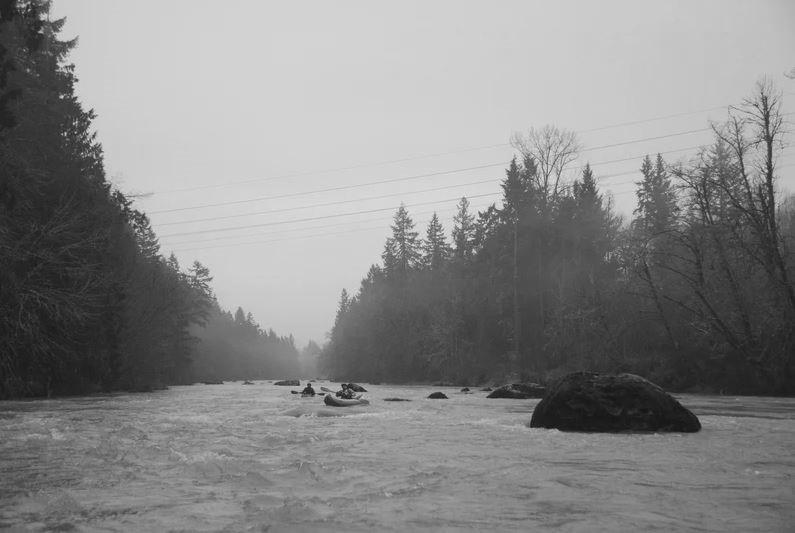
Below left: Joseph Alongi enjoyed fishing. Photograph courtesy of Joe Alongi.

Below right: Joe Alongi, son of Carnegie medal winner Joseph Alongi, poses with his father’s medal. Photograph by author.

boat but were unable to maintain a hold on it as it was revolved by the current. Alongi then sank and remained submerged as the other firemen and the helicopter arrived at the scene. Ellis, McDaniel, and Parker were removed from the water by means of a rope ladder lowered from the helicopter. Searchers found Alongi's body the following day. Ellis was treated for shock, McDaniel suffered from exposure, and Parker was hospitalized overnight. They recovered.”9
Alongi was survived by his wife and two young children. It is unknown who proposed the incident to the Carnegie Hero Fund (Alongi’s son thinks it might have been the fire department), but in 1959, medals were awarded to Ellis and to Alongi’s widow.10
James Carignan, 19, of Olympia had joined the Coast Guard, and in the summer of 1972, was stationed on the cutter Modoc at the Coos Bay Coast Guard station on the Oregon coast. On Saturday, June 3, Carignan was off-duty at Bastendorff Beach near Coos Bay.
Others were also enjoying the beach that day. Terrisa Voepel and Nancy Manock, both twelve, were playing in the surf when a wave knocked them over and the current sucked them away from the beach. Nancy’s mother, Betty Rae Manock, 49, immediately swam to the girls’ rescue. Nancy managed to regain the beach, but Betty
Manock and Voepel were in serious trouble in breaking surf eight to ten feet high.11
Carignan jumped into the surf and struck out after Voepel and Manock. Another man, Mike Terry of Concord, California, joined Carignan. All four were being swept out to sea by the strong current. Carignan, Manock, and Terry drowned in their attempts to bring the girl in through the heavy surf.
“Miss Voepel . . . eventually was rescued by Coast Guard YN3 Michael Nelson, 20, of the Coos Bay Life Boat Station, who took her out beyond the breakers and kept her afloat for about 40 minutes until a lifeboat arrived.”12 Voepel was taken to a local hospital where she was reported in satisfactory condition.
Carignan’s body was recovered almost three weeks later.
Carignan, Manock, and Terry all were awarded Carnegie medals posthumously in 1974.13 Nelson also won a medal for his part in the rescue.
On a damp day in October 1985, Rainier resident Cheryl Huret was driving a pick-up truck east on the Yelm Highway. Huret’s two daughters, Tracey, 9, and Jamie, 2, were in the truck with her. On the rain-slicked pavement on an S-curve, Huret lost control of the truck, which left the
roadway and crashed into two large trees. Huret was knocked unconscious.14
Tenino resident Charles B. McCracken, 30, and Olympia resident Rickard Spillman, 40, witnessed the accident and pulled over to help. As McCracken approached the pick-up, he saw flames under the engine. Nevertheless, the two men managed to extract the girls and carry them away from danger. McCracken and Spillman then returned to the burning truck and freed the unconscious Huret who was wedged between the steering wheel and the floor. Just after they pulled the woman from the cab, the truck erupted in flames which reached 30 to 40 feet into the air.
Huret was transported to St. Peter Hospital in serious condition, with a broken jaw, broken wrist, and other injuries. Her daughters received only minor injuries. A State Patrol officer said “No doubt if they had been left in the truck, they would have died.”15
After Huret recovered from her injuries, she contacted the Carnegie Hero Fund to nominate her rescuers. The commission agreed that Spillman and McCracken deserved an award. A year later, the men each received a Carnegie medal and a $2,500 check for their valor. A newspaper interview with Spillman revealed that he thought he “really didn’t do all that much,” but was glad that he could help someone in need.16

With the proliferation of school shootings in recent years, it seems inevitable that a Thurston County school would eventually be affected.
Near the beginning of a school day in April 2015, a 16-year-old boy brought a loaded .357 revolver to the North Thurston High School where he had been a student for only a month. He fired a shot into a stairway ceiling, and then walked into the school’s commons area, which was crowded with students and staff before classes started. A government/civics teacher, Brady Olson, 43, “was in the commons when the shot was fired and immediately ran the 50 feet to the stairs. The assailant proceeded into the commons, passing Olson, and fired another shot, also into the ceiling. Olson approached the assailant, grasped his gun hand, and tackled him to the floor. Pinning the assailant, Olson got possession of the revolver and removed it from him. Other men who were responding secured the weapon and helped restrain the assailant until police arrived shortly and arrested him. Olson sustained a minor injury to a finger but recovered.”17
An NBC News affiliate interviewed Olson after the incident, and in what seems to be a typically humble reaction from a hero, Olson said “It was just one of those things. I saw kids fleeing and it kind of fired me up to do something and I did it. It’s as simple as that.”18
On July 30, 2018, 67-year-old Alan E. Rathbun was driving along Cooper Point Road when he suffered a diabetic emergency. His SUV “left a two-lane road and traveled down an embankment into a ditch containing grass and dry brush.”19 Heather Zabrowski, 29, of Olympia, was driving down the same road when she saw the accident. Fire had already broken out beneath the SUV and was quickly spreading.
Other people were standing on the edge of the road, just looking at the accident, when Zabrowski jumped out of her car and asked “Is there somebody in there?” The onlookers said there was, and Zabrowski “jumped down in the ditch and ripped open the car door . . . She got the seat belt free, but the driver was in shock and not able to get out himself.” After unlatching the seatbelt, Zabrowski pulled Rathbun out of the SUV onto the ground, but was unable to lift him any farther. She called up to the onlookers for assistance. By this time, the flames had spread to the rear and interior of the vehicle. The property owner, a former firefighter, knocked the flames down, and Zabrowski finally got two men to help her carry the driver to safety. Rathbun was not seriously hurt, but needed treatment for diabetic shock. Zabrowski suffered minor scratches.20 Through her efforts that day, she became the latest Thurston County resident to receive a Carnegie medal.
Anyone has the capacity to be a hero, but few of us find or take the opportunity. We should all appreciate and applaud the actions of our Thurston County heroes who exemplify the Biblical quotation that appears on the Carnegie medal itself: “Greater love hath no man than this, that a man lay down his life for his friends.”
For further information and descriptions of all award winners’ courageous actions, visit www.carnegiehero.org.
2 “The Heroes of Harwick,” “History,” www.carnegiehero.org/ about/history/ (accessed October 26, 2020).
3 “The Heroes of Harwick.”
4 “Mission of the Carnegie Hero Fund Commission,” www.carnegie hero.org/ (accessed November 3, 2020).
5 “Mission of the Carnegie Hero Fund Commission.”
6 “Heroes of Civilization,” “History,” www.carnegiehero.org/about/ history/ (accessed October 27, 2020).
7 “Joseph Alongi, Yelm, Washington,” Carnegie Hero Fund Commission, mychfc.org/hero.aspx?hero=44320 (accessed November 3, 2020).
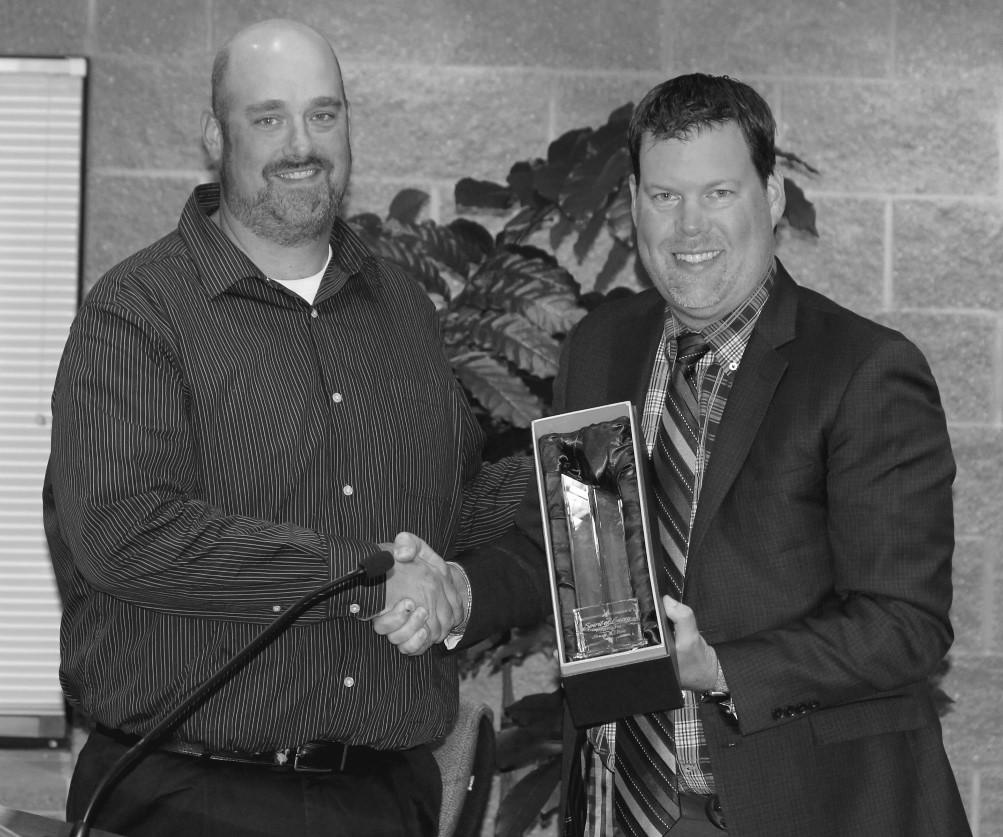
8 Author interview with Joe Alongi, February 2021.
9 “Joseph Alongi, Yelm, Washington.”
10 “Yelm Men Who Helped Save Two Honored,” Seattle Daily Times, January 30, 1959, page 11.
11 “Three drown helping girl,” Bellingham Herald, June 5, 1972, page 10.
1 “The Harwick Disaster,” “History,” www.carnegiehero.org/about/history/ (accessed October 26, 2020).
“Man Dies In Try To Save,” Morning Olympian, June 5, 1972, page 6. “Medal given posthumously,” Oregonian, June 12, 1973, page 12. “James Leo Carignan, Olympia, Washington,” Carnegie Hero Fund Commission, my-
chfc.org/hero.aspx?hero=52701 (accessed November 3, 2020).
12 “Medal given posthumously.”
13 “Carnegie Award For Carignan’s Heroic Effort,” Morning Olympian, May 2, 1974, page 2.
14 “Charles B. McCracken, Tenino, Washington,” Carnegie Hero Fund Commission, mychfc.org/hero.aspx? hero=60753 (accessed November 3, 2020). “Rickard G. Spillman, Olympia, Washington,” Carnegie Hero Fund Commission, mychfc.org/hero.aspx? hero=60754 (accessed November 3, 2020).
15 “Trooper credits motorists with saving 3 lives,” Morning Olympian, October 27, 1985, pages 1 and 11.
16 “A modest hero,” Tacoma News Tribune, December 24, 1986, page 9.
17 “Brady Olson, Lacey, Washington,” Carnegie Hero Fund Commission, mychfc.org/hero.aspx?hero=87347 (accessed November 3, 2020).
18 Phil Helsel, “Teacher Brady Olson Who Tackled Shooter Comforted Gunman,” NBC News, www.nbcnews.com/ news/us-news/ (accessed November 3, 2020).
19 “Heather Zabrowski, Olympia, Washington,” Carnegie Hero Fund Commission, mychfc.org/hero.aspx? hero=90033 (accessed November 3, 2020).
20 Keith Eldridge, “Woman saves driver from fiery crash near Olympia,” KOMO News, www.komonewscom/news/ local/ (accessed November 3, 2020). “Heather Zabrowski, Olympia, Washington.”
Karen L. Johnson has worked in the museum field since 2001. She has written many history articles and coauthored two books about a Washington pioneer. She currently serves as the curator at the Olympia Tumwater Foundation, and as the editor of the Thurston County Historical Journal.
Can you identify any of the women on the facing page? The photo was taken on November 30, 1973 at the Tumwater Valley Golf Course. Shown are all the female employees of the Olympia Brewing Company at that time. Please contact the Journal editor at karen@olytumfoundation.org if you can fill in any of the blanks. Photograph courtesy of Gail Dahm.
1 Penny Webster
2 Lalonie ______ 3 Caroline Huber
4 Beth Bryarly
5—Shirley Wibbles
6
—Christie ______ 7—Jo Blessing
8 Pat ______
9 Winona Martin (retired)
10 Muriel Fuller (retired)

Do you recognize this photo of a Gothic revival home?
The photo is from the collection of the Washington State Historical Society (catalog number 2018.0.80). The house is described as: “a T-shaped structure with trim at eaves. A second floor balcony extends over a doorway supported by four columns. Tall sashed windows are visible on both floors. A group of three women and a man stand at the entry way. A picket fence is in front of the home, and a sidewalk extends along it. A woman is standing on the sidewalk.
“Behind the home we can see a bridge spanning a gully or river, and behind this, on a hillside, is a large two story
structure with a bell tower, possibly a school.
“This home was identified on sleeve as the Nathaniel Crosby House in Olympia, WA, Thurston County. This is not, however, the Nathaniel Crosby House in Tumwater, WA and no other Nathaniel Crosby home is known.”
The house is also not the Daniel and Ann Elizabeth Bigelow House in Olympia.
If you have any clues about this house’s identity, or the identity of the building on the left, please email the Journal editor at karen@olytum foundation.org.

In its early history, this residence (commonly known as “the Ferry mansion” in its day) was occupied by some prominent families: Ferry, McGraw, and Schmidt. The house was built sometime prior to September 1891, and was occupied until 1895 by Governor Elisha P. Ferry and his wife Sarah. Ferry served as Washington State’s first governor, from 1889 to 1893.
Ferry died while on a trip to Seattle in October 1895. His wife then took up permanent residence in Seattle, and rented the house in Olympia to thenGovernor John McGraw. McGraw and his wife May had been living in the Ford residence at Columbia and 11th . McGraw must have been a little slow in making the move to their new home on Main while he was on an out-of-town trip, his wife took charge and had all their household effects moved to the Ferry house. McGraw returned the next morning on the train, went directly to his office, then walked “home” for lunch, only to find the door locked and the house deserted. The Yakima Herald of November 28, 1895 reported, “Glancing around to see whether any of the neighbors had observed him, the governor got out of there as fast as circumstances would permit and made tracks for his new home on upper Main street.”
In 1897, Mrs. Ferry offered to rent the home to Governor John Rogers. However, he did not fancy living there, leaving the house available for another tenant.
Meanwhile, Leopold F. Schmidt had moved from Montana to Washington, and started building his new brewery in Tumwater. Finding no home in Olympia roomy enough for his large family, Schmidt housed his wife and children in Portland for a time, while he commuted between that city and Tumwater. In February 1897, the Schmidts moved into the Ferry mansion after Governor Rogers declined the rental. The Schmidts lived there until 1902. They then moved to a house a few blocks north while their large home, today’s Schmidt House, was being built in Tumwater.
The Ferry home was finally demolished in late 1949 to make way for construction of the Maple Vista Apartments, which still exist and are now known as the Capitol Terrace Apartments, located at 1517 Capitol Way S.
Back cover: Ferry residence, photograph C1949. 1224.2, Washington State Historical Society, www.WashingtonHistory.org (accessed February 19, 2021).
Governor Elisha P. Ferry, State Library Photograph Collection, 1851-1990, Washington State Archives, Digital Archives (accessed February 19, 2021).
Sanborn Fire Insurance Map, Olympia, Thurston County, Washington, June 1896, Library of Congress, www.loc.gov (accessed February 19, 2021).
Who lived in this lovely Victorian house, once located near the intersection of Main Street (now Capitol Way) and Maple Park in Olympia? See inside back cover for more information.
